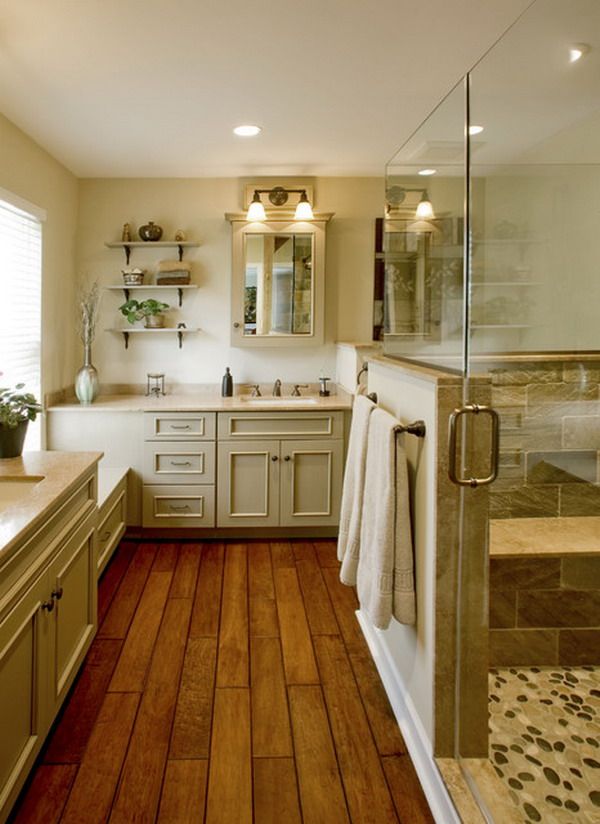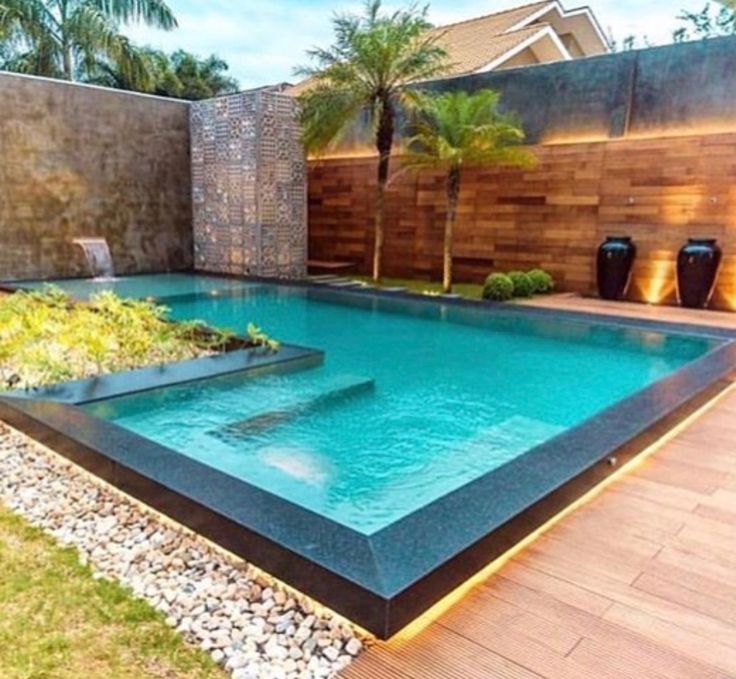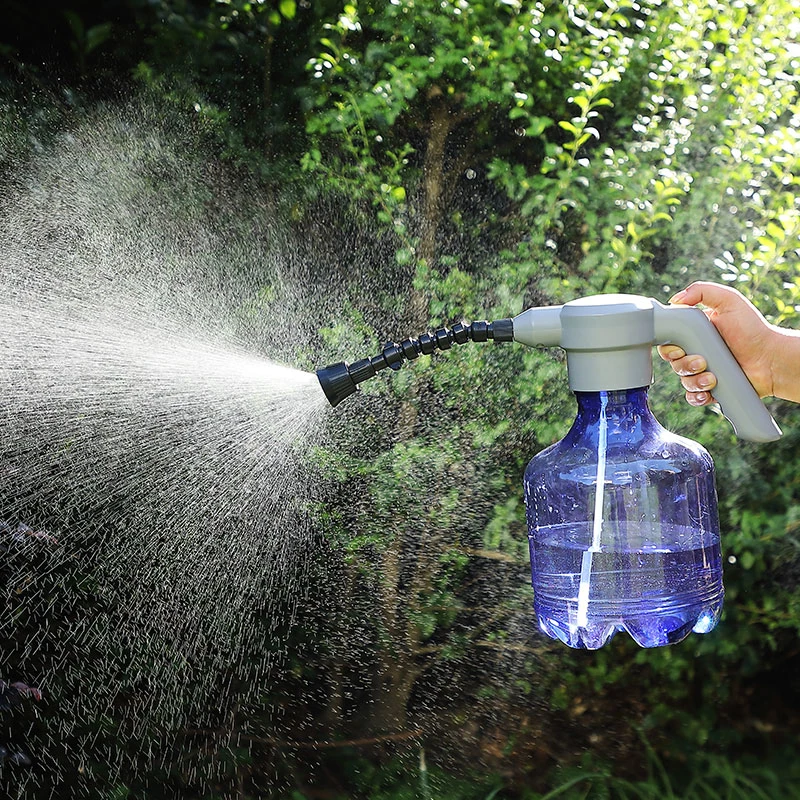Top 10 small evergreen shrubs
Top 10 evergreen shrubs for small gardens
Add year round colour & structure to your garden using evergreen shrubs
Image: Daphne 'Eternal Fragrance' from Thompson & Morgan
As gardens continue to shrink, plant breeders have responded by developing a wide range of compact varieties. Designed to flourish in narrow borders or containers, these compact evergreen shrubs take up a fraction of the space of their parent species. So whether you’re searching for flamboyant flowers or fabulous foliage, here are ten of our favourite evergreen shrubs chosen especially for small gardens:
- Pieris japonica 'Little Heath'
- Sarcococca hookeriana var. humilis
- Dwarf rhododendrons
- Nandina domestica 'Fire Power'
- Euonymus
- Dwarf conifers
- Hebe
- Mahonia 'Soft Caress'
- Daphne
- Leucothoe
Admired for its pretty variegated foliage, 'Little Heath' can be grown in containers or the ground
Image: Pieris japonica 'Little Heath' from Thompson & Morgan
Pieris is an acid-loving shrub, but if your soil doesn't suit, it makes a fine container plant too. Pieris japonica 'Little Heath' has a tight, bushy habit with eye-catching variegated foliage. Creating a superb focal point, there’s lots of seasonal interest to be had too. New tips emerge in pink, and from March to May, generous clusters of cream, bell-shaped flowers appear. With a height and spread of just 60cm (24"), this small evergreen shrub is perfect for a sunny or lightly shaded spot!
This compact sarcococca has creamy-white, scented flowers from November to May
Image: Sarcococca hookeriana var. Humilis from Thompson & Morgan
Sarcococca hookeriana var. humilis is at its best in the depths of winter and early spring when the spidery white flowers release the most exquisite honeyed fragrance. The perfume is powerful, so plant it close to the house where you can enjoy it every time you pass. The nectar rich flowers and glossy, black berries which follow are loved by wildlife, making it a great choice for encouraging nature into your garden.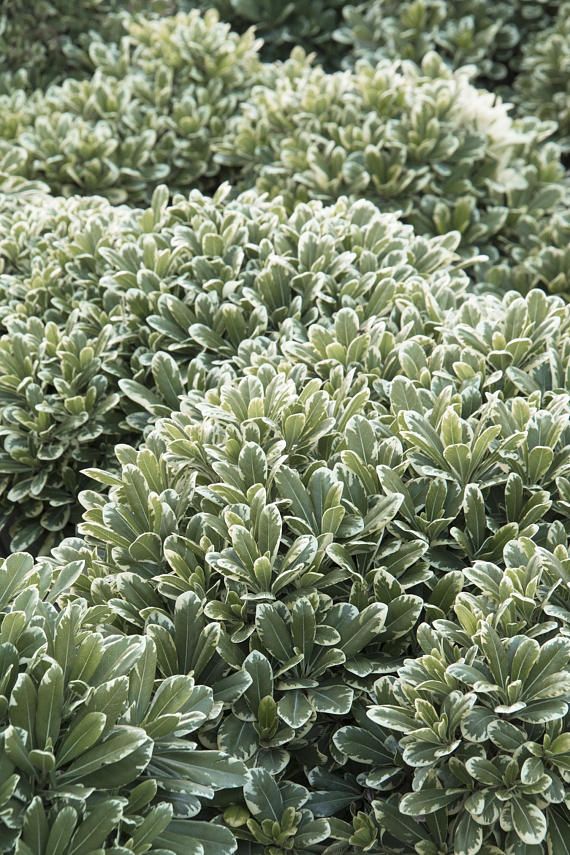 This is one of the most compact of the Sarcococcas, growing to just 1m (3') in height and spread.
This is one of the most compact of the Sarcococcas, growing to just 1m (3') in height and spread.
Dwarf rhododendrons are easy-to-keep evergreen shrubs
Image: Azalea 'Dwarf Pink' from Thompson & Morgan
It's easy to dismiss rhododendrons as too large for a small garden, but a wide range of compact varieties have recently been developed. Dwarf rhododendrons remain neat and compact but still produce the eye-popping blooms that make these acid-loving evergreen shrubs so dazzling in springtime. They make fabulous small evergreens for pots!
Rhododendron 'Blue Tit' reaches a mature height of just 90cm height and spread and, if you have a large container to spare, the magenta pink blooms of Rhododendron 'Amoena' make a bold spring display!
'Fire Power' is a popular and well-loved variety with a compact dwarf habit
Copyright: Visions BV, Netherlands
If you like to see leaves changing colour in autumn, the small semi-evergreen Nandina domestica 'Fire Power' is a great choice.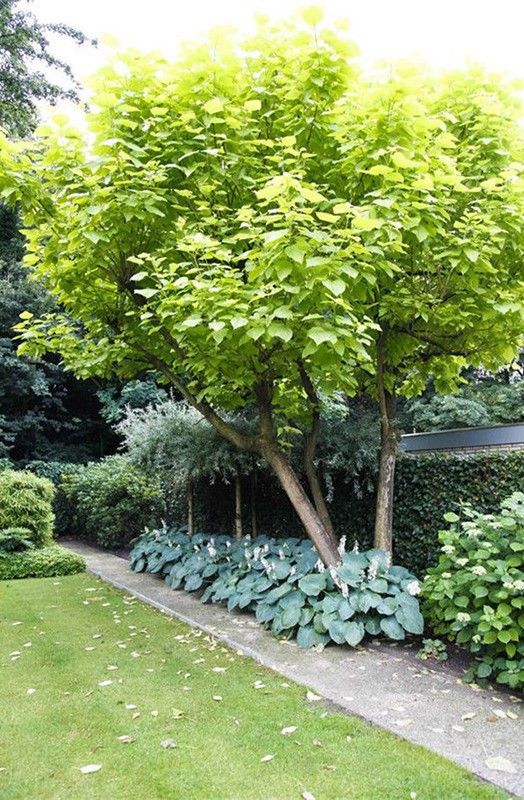 This dwarf variety grows to just 45cm tall (60cm spread) but, particularly in milder locations, retains some of its foliage over winter after putting on a good autumn show.
This dwarf variety grows to just 45cm tall (60cm spread) but, particularly in milder locations, retains some of its foliage over winter after putting on a good autumn show.
Nandina is famed for its dramatic colour changes – new foliage emerges in gold before ageing to green. In autumn it transforms to rich shades of red and mahogany. Add to this a fine display of starry white blooms and glossy red berries in summer, and you have the perfect small shrub for all seasons!
Hardy and versatile, Euonymus japonicus 'Himalaya' is a popular choice for low hedging
Copyright: Plantipp / Visions BV, Netherlands
Few shrubs can beat Euonymus for providing constant, robust, evergreen colour and, aside from an annual increase in size, they remain virtually unchanged throughout the year. Many varieties boast bright, glossy foliage that provide a splash of gold like Euonymus fortunei 'Emerald 'n' Gold' or Euonymus fortunei 'Blonde Beauty'. For a more subtle and elegant variegation, try Euonymus fortunei 'Harlequin' which boasts an irregular cream margin to each dark green leaf.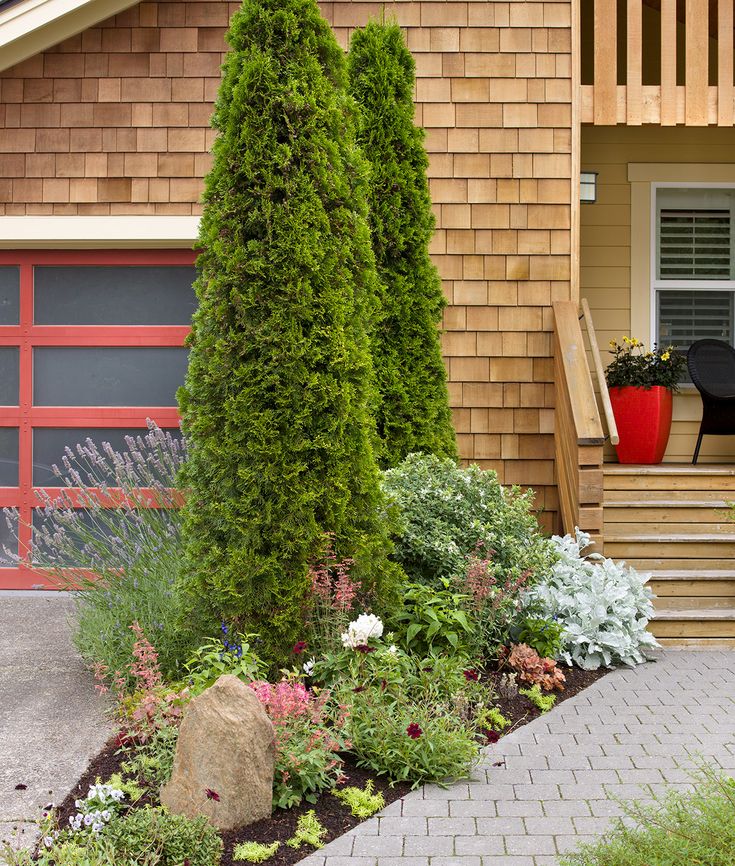 These small shrubs reach no more than 1m (3') in height and spread, making useful ground cover, or a handsome evergreen container plant.
These small shrubs reach no more than 1m (3') in height and spread, making useful ground cover, or a handsome evergreen container plant.
For height without width, 'Compressa' has an architectural, slim, vertical habit
Image: Juniperus communis 'Compressa' from Thompson & Morgan
Dwarf conifers may have fallen from fashion since the 1970s - but don't dismiss these hardworking plants. The ultimate low-maintenance evergreen shrubs, conifers need virtually no extra care once established. Their diversity of colour, texture, shape and form is astonishing! Try Thuja occidentalis 'Tiny Tim' in containers either side of a doorway - with a naturally rounded habit they make a great alternative to traditional Box topiary.
Cryptomeria are useful for providing evergreen seasonal colour, turning bronze in autumn and returning to green by summer. For a more rugged appearance, look to dwarf Pines for their needle-like foliage. If you prefer to stick to a more traditional conical shape then Platycladus orientalis 'Aurea Nana' is hard to beat.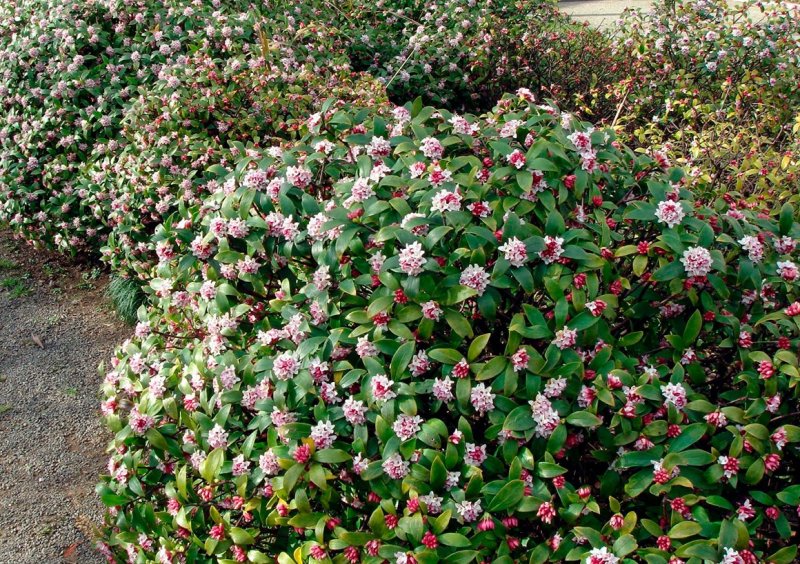
'Silver Queen' is well suited to growing in containers, at the front of borders or as a low hedge
Image: Hebe 'Silver Queen' from Thompson & Morgan
Hebes come in all shapes, colours and sizes, making them some of the best small evergreen shrubs for sun, especially on free-draining soils. With their nectar-rich flower spikes in summer, these compact evergreen shrubs are perfect for attracting bees and butterflies to the garden too. There are plenty of varieties that grow to less than 1m (3') height and spread.
Hebe 'Silver Queen' boasts colourful variegated foliage and mauve flower spikes. For a more elegant variegation, try Hebe 'Silver Anniversary' which has slender, grey-green leaves with irregular, silvery margins. Cold winter weather brings about a gentle purple tint that makes a lovely feature when there’s little other colour in the garden.
A superb evergreen shrub, 'Soft Caress' won RHS Chelsea Plant of the Year 2013
Image: Mahonia 'Soft Caress' from Thompson & Morgan
Mahonia certainly isn't the first evergreen shrub that you would think of for a smaller garden, especially with those spiky stems! That's what makes Mahonia 'Soft Caress' so different.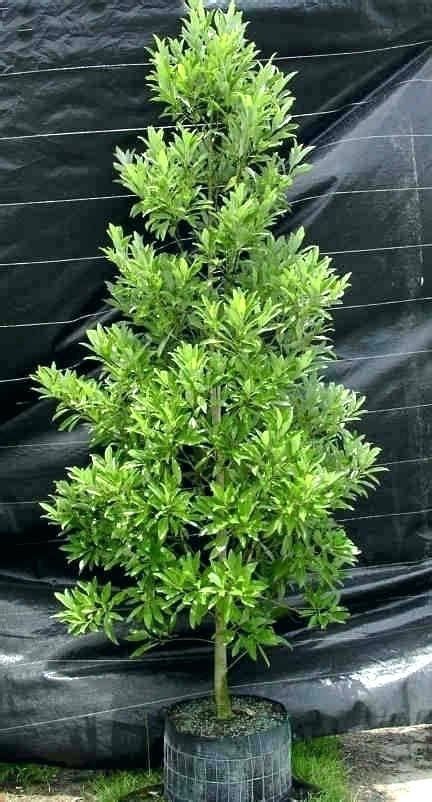 This is the first spine-free, dwarf mahonia variety, reaching a height and spread of just 120cm (4').
This is the first spine-free, dwarf mahonia variety, reaching a height and spread of just 120cm (4').
The foliage is slender and elegant, reminiscent of bamboo, but when the golden flower spikes appear, there can be no mistaking its species! The sweetly fragrant blooms appear in autumn, just when the fading garden needs a splash of colour. A superb small evergreen shrub for sun or semi-shade!
Blooming from April to October, Daphne 'Pink Fragrance' is unbeatable for flowers and fragrance
Image: Daphne x transatlantica 'Pink Fragrance' from Thompson & Morgan
No list of small evergreen shrubs would be complete without the beautiful Daphne! The richly perfumed flowers are a treat for the senses from spring right through to autumn.
Daphne 'Eternal Fragrance' and Daphne x transatlantica 'Pink Fragrance' both flower on new growth, so the flowers just keep coming. With a compact habit, reaching less than 1m (3') in height and spread, these glamorous evergreens are perfect for a container or border next to a well-used seating area.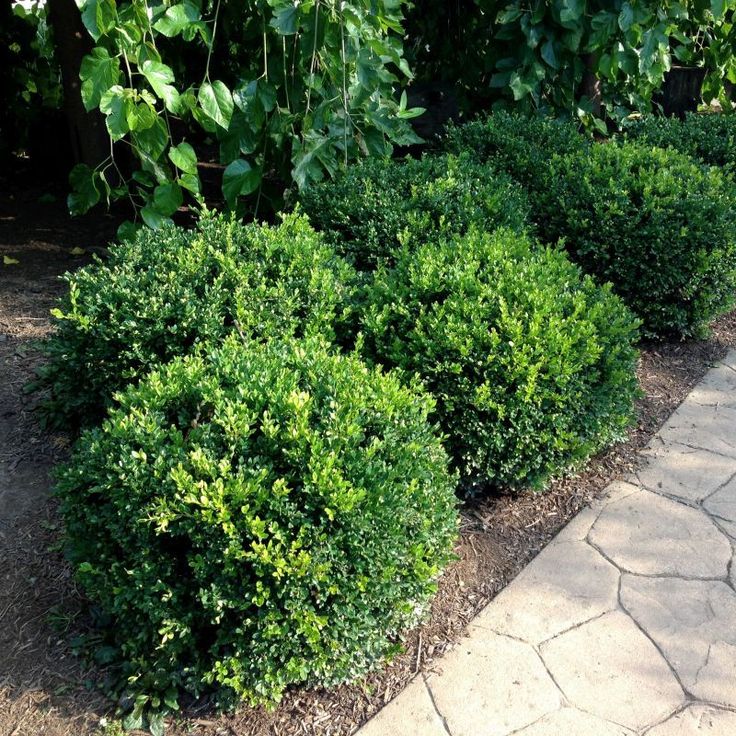
'Little Flames' is a compact, evergreen shrub that boasts superb autumn colour
Image: Leucothoe axillaris 'Little Flames' from Thompson & Morgan
Now here's one for the gardener who likes something different! Leucothoe is rarely seen in UK gardens as it enjoys a rich, acid soil, but it’s just as happy in a container of ericaceous compost. This is the perfect small evergreen shrub for shade, bringing interest to those difficult, dark areas of the garden.
Boasting colourful stems tips as the new growth emerges, and later in autumn the leaves turn to vibrant autumnal shades. Racemes of white, urn-shaped flowers cascade from its stems in spring. Try Leucothoe axillaris 'Little Flames' for a dynamic blaze of colour. For a more subtle display look to the gentle variegated tones of Leucothoe fontanesiana 'Whitewater'.
So there you have it - our pick of the best evergreen shrubs for small gardens. By incorporating just a few small evergreen shrubs in borders and containers, you can keep your garden looking fresh and colourful throughout the year.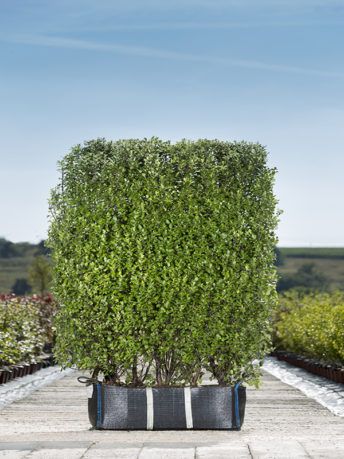 For more inspiration and advice, head to our dedicated shrubs hub page now.
For more inspiration and advice, head to our dedicated shrubs hub page now.
8 Best Small Evergreen Shrubs
By
David Beaulieu
David Beaulieu
David Beaulieu is a landscaping expert and plant photographer, with 20 years of experience. He was in the nursery business for over a decade, working with a large variety of plants. David has been interviewed by numerous newspapers and national U.S. magazines, such as Woman's World and American Way.
Learn more about The Spruce's Editorial Process
Updated on 10/05/21
Reviewed by
Kathleen Miller
Reviewed by Kathleen Miller
Kathleen Miller is a highly-regarded Master Gardener and Horticulturist who shares her knowledge of sustainable living, organic gardening, farming, and landscape design. She founded Gaia's Farm and Gardens, a working sustainable permaculture farm, and writes for Gaia Grows, a local newspaper column. She has over 30 years of experience in gardening and sustainable farming.
She has over 30 years of experience in gardening and sustainable farming.
Learn more about The Spruce's Review Board
The Spruce / Autumn Wood
When you think of small evergreen shrubs, do you picture uninteresting lumps of green dotting a landscape? There are actually many compact bushes out there that are quite colorful characters. These shrubs grow only a few feet in height and spread, but they sport bright blooms and interesting foliage that goes well beyond a basic green. Here are eight small evergreen shrubs that can liven up any garden.
Tip
"Evergreen" means the plant retains its foliage throughout the year, but it's a bit of a misnomer because that foliage is not necessarily green. For instance, some plants maintain a golden color year-round.
Identify Common Evergreen Shrubs With This Picture Guide
-
01 of 08
The Spruce / David Beaulieu
Many first-time growers of this small evergreen shrub quickly become impressed with its prodigious blooming period.
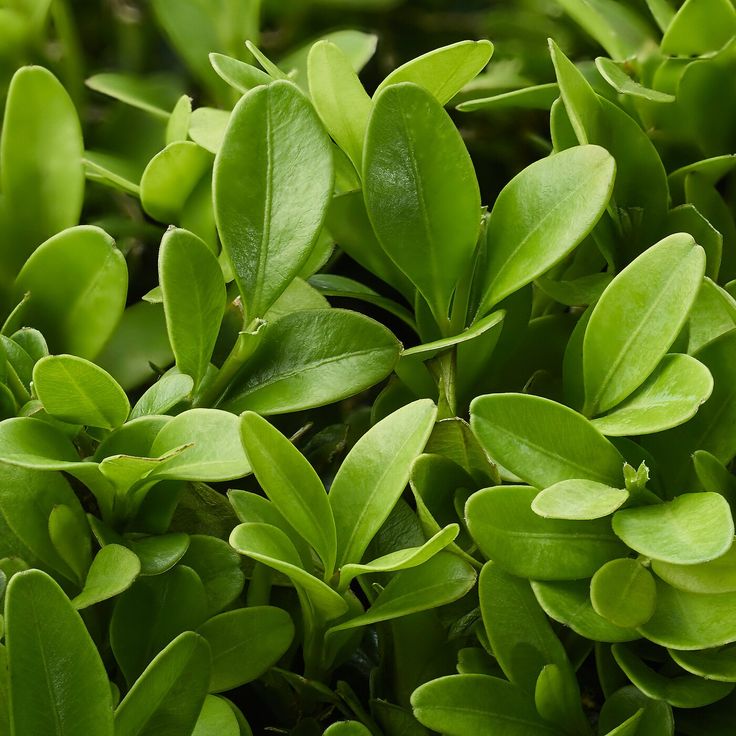 Winter heath lives up to its name by putting out flowers in the most unlikely of seasons: wintertime. And if the climate and conditions are right, it might end up flowering for about half the year. The shrub grows to around a foot in height and spread, and it works well in rock gardens and on slopes.
Winter heath lives up to its name by putting out flowers in the most unlikely of seasons: wintertime. And if the climate and conditions are right, it might end up flowering for about half the year. The shrub grows to around a foot in height and spread, and it works well in rock gardens and on slopes. - USDA Growing Zones: 5 to 7
- Color Varieties: Pink or purple blooms
- Sun Exposure: Full sun to part shade
- Soil Needs: Sandy, loamy, acidic, medium moisture, well-draining
-
02 of 08
The Spruce / K. Dave
Mountain laurel (Kalmia latifolia 'Minuet') is a broadleaf evergreen that you might be familiar with if you've walked through New England woods in June. In fact, it is the state flower of Connecticut. The laurel bushes you find in the forest can become quite large, but the 'Minuet' cultivar—true to its name—is a dwarf, growing only around 2 to 3 feet in height and spread.
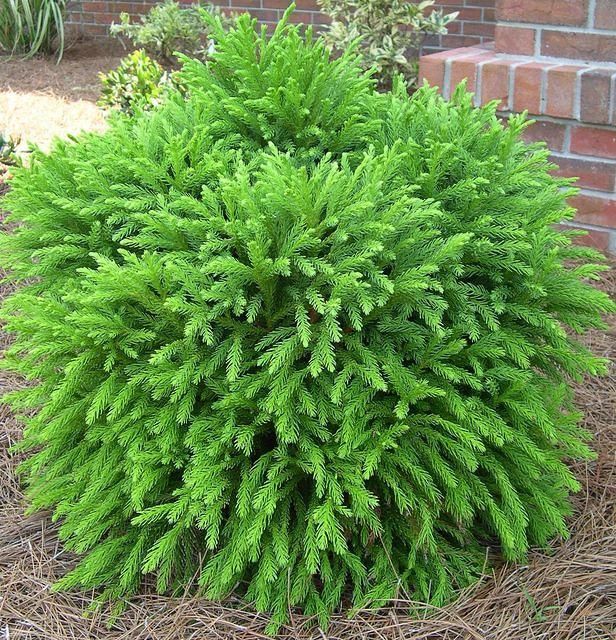 Plus, this compact bush offers another advantage over its wild relatives: Its flowers are more colorful. Lightly prune the plant after it is finished blooming to keep it looking full and bushy.
Plus, this compact bush offers another advantage over its wild relatives: Its flowers are more colorful. Lightly prune the plant after it is finished blooming to keep it looking full and bushy. - USDA Growing Zones: 4 to 9
- Color Varieties: White with a purplish-red band
- Sun Exposure: Part shade
- Soil Needs: Rich, humusy, acidic, moist, well-draining
-
03 of 08
The Spruce / Evgeniya Vlasova
Blue star juniper (Juniperus Squamata 'Blue Star') is strictly a foliage plant. If you like the look of blue spruce trees but lack the room for something so big, consider scaling down and growing blue star juniper. This plant grows to roughly 1 to 3 feet tall with a 1- to 4-foot spread. With its short blue-green needles, blue star juniper looks especially nice planted next to shrubs with golden foliage. The plants also can be massed to form a ground cover.
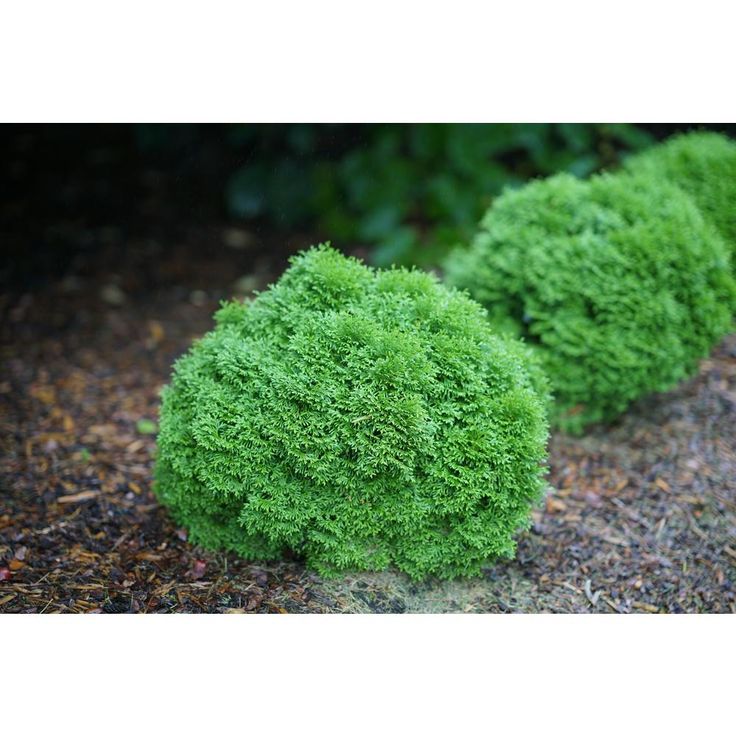
- USDA Growing Zones: 4 to 8
- Color Varieties: Blue-green foliage
- Sun Exposure: Full sun
- Soil Needs: Average, medium moisture, well-draining
Why Dwarf Trees: The Ideal Choice for Small-Yard Design
-
04 of 08
The Spruce / Autumn Wood
Euonymus is a genus that includes evergreen shrubs exhibiting some sort of variegation in their leaves. The 'Emerald 'n' Gold' cultivar explains the look of its bicolored leaves with its name. Its foliage is emerald at the center and gold at the margin. 'Emerald 'n' Gold' grows only to around 2 feet tall with a 2- to 4-foot spread. This plant is tolerant of many growing conditions and has the potential to become invasive. Keep it pruned to prevent it from spreading into lawns and climbing trees.
- USDA Growing Zones: 5 to 8
- Color Varieties: Green and gold foliage, greenish-white flowers
- Sun Exposure: Full sun to part shade
- Soil Needs: Average, medium moisture, well-draining
-
05 of 08
The Spruce / Evgeniya Vlasova
Another bicolored euonymus, 'Emerald Gaiety' offers a different color combination from 'Emerald 'n' Gold'.
 Its leaves are green and white instead of green and gold. The white in the leaves gives this small evergreen shrub an overall bright appearance, which might account for its cheerful name. It grows roughly 3 to 5 feet in height and spread. And despite its classification as a shrub, the plant also can be trained to grow as a vine. Provide support, such as a trellis or mailbox post, and the branches will wind their way up.
Its leaves are green and white instead of green and gold. The white in the leaves gives this small evergreen shrub an overall bright appearance, which might account for its cheerful name. It grows roughly 3 to 5 feet in height and spread. And despite its classification as a shrub, the plant also can be trained to grow as a vine. Provide support, such as a trellis or mailbox post, and the branches will wind their way up. - USDA Growing Zones: 5 to 8
- Color Varieties: Green and white foliage, greenish-white flowers
- Sun Exposure: Full sun to part shade
- Soil Needs: Average, medium moisture, well-draining
-
06 of 08
'Moonshadow' (Euonymus fortunei 'Moonshadow')
The Spruce / David Beaulieu
The 'Moonshadow' euonymus also has a green-and-gold pattern of variegation. But its colors are the opposite of 'Emerald 'n' Gold' with green at the margins and gold at the centers.
 On some of the leaves, you might see the gold color replaced by an off-white, which happens as the growing season wears on. 'Moonshadow' grows densely to about 3 feet tall with a similar spread, and it only requires a little pruning to keep the bush compact.
On some of the leaves, you might see the gold color replaced by an off-white, which happens as the growing season wears on. 'Moonshadow' grows densely to about 3 feet tall with a similar spread, and it only requires a little pruning to keep the bush compact. - USDA Growing Zones: 4 to 9
- Color Varieties: Green and gold foliage, greenish-white flowers
- Sun Exposure: Full sun to part shade
- Soil Needs: Average, medium moisture, well-draining
-
07 of 08
The Spruce / Cara Cormack
Dwarf English boxwood (Buxus sempervirens 'Suffruticosa') is not as colorful as some other small evergreen shrubs, but its classic green foliage is attractive in its own right. The plant grows slowly to roughly 2 to 3 feet tall with a slightly wider spread. It works well as a border or even in a container, and it makes a good foreground or background for other plants. Pruning to keep things neat and uniform will be your primary maintenance task when growing several of these shrubs as a hedge.
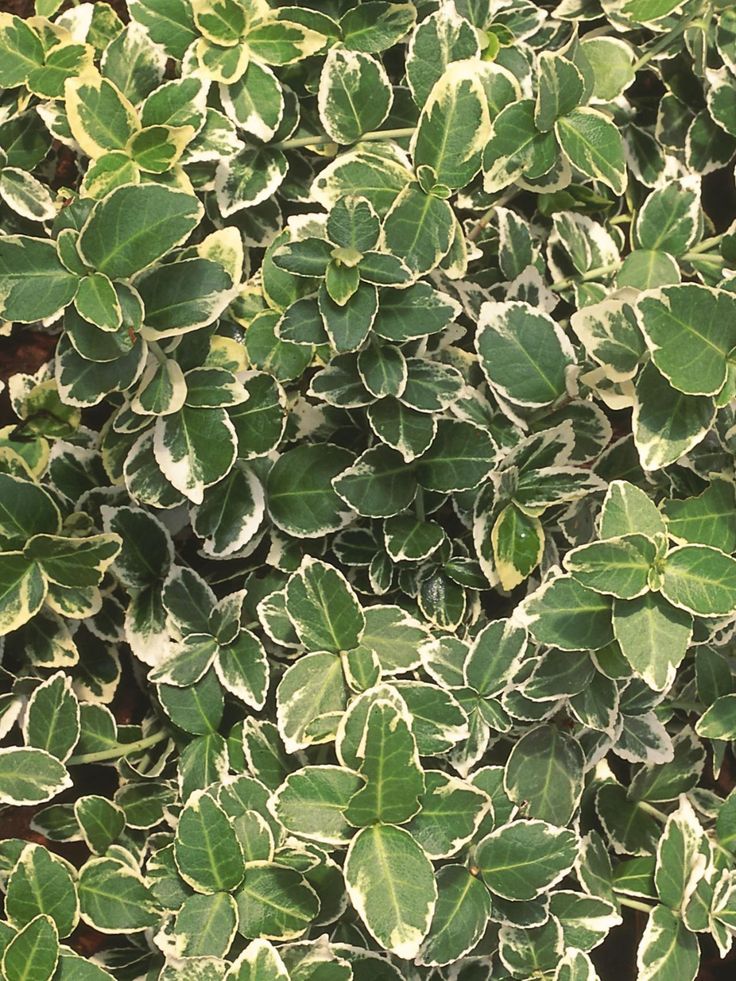 The plant also likes a layer of mulch to keep the soil moist and protect it from heat.
The plant also likes a layer of mulch to keep the soil moist and protect it from heat. - USDA Growing Zones: 6 to 8
- Color Varieties: Medium green foliage
- Sun Exposure: Full sun to part shade
- Soil Needs: Evenly moist, well-draining
-
08 of 08
The Spruce / Letícia Almeida
When several plants are massed together, yuccas can form an impressive display during their blooming period. Adam's Needle (Yucca filamentosa) grows only a few feet tall, though it shoots up a flower stalk in late spring that reaches around 6 feet. The plant is useful for a dry area of the garden where other plants might not grow. Moreover, the varieties with golden foliage, such as 'Garland’s Gold' and 'Golden Sword', are a good choice if you want something other than green.
- USDA Growing Zones: 5 to 10
- Color Varieties: Green foliage, white flowers
- Sun Exposure: Full sun
- Soil Needs: Light, dry to medium moisture, well-draining
Evergreen shrubs for central Russia
Ornamental shrubs for central Russia
Shrubs are a very useful thing on the site.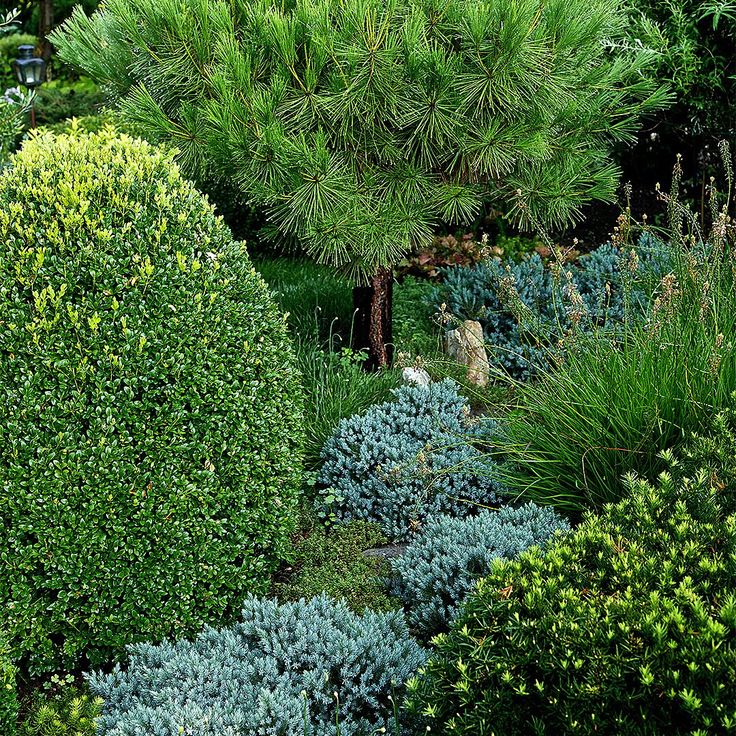 After all, with the right selection of plants, you can make the territory very aesthetically attractive. Shrubs can be of different types, which further expands the possibilities for creative flight.
After all, with the right selection of plants, you can make the territory very aesthetically attractive. Shrubs can be of different types, which further expands the possibilities for creative flight.
What are the benefits of planting ornamental shrubs for your garden?
- They serve as a hedge, which can save money on a fence.
- With the help of shrubs, you can divide the site into separate zones.
- Shrubs of different levels, together with a pond, are the aesthetic center of the site.
- If there are places on the territory that look ugly, then it is with the help of shrubs that this problem can be easily solved.
So, the pros have been mentioned a little, but how to choose the right plants for your garden. Everything is easier with flowers, but not everyone knows about shrubs. Below we will talk about garden ornamental shrubs, their types and features of choice for central Russia. It has its own nuances, the climate in the regions is harsh.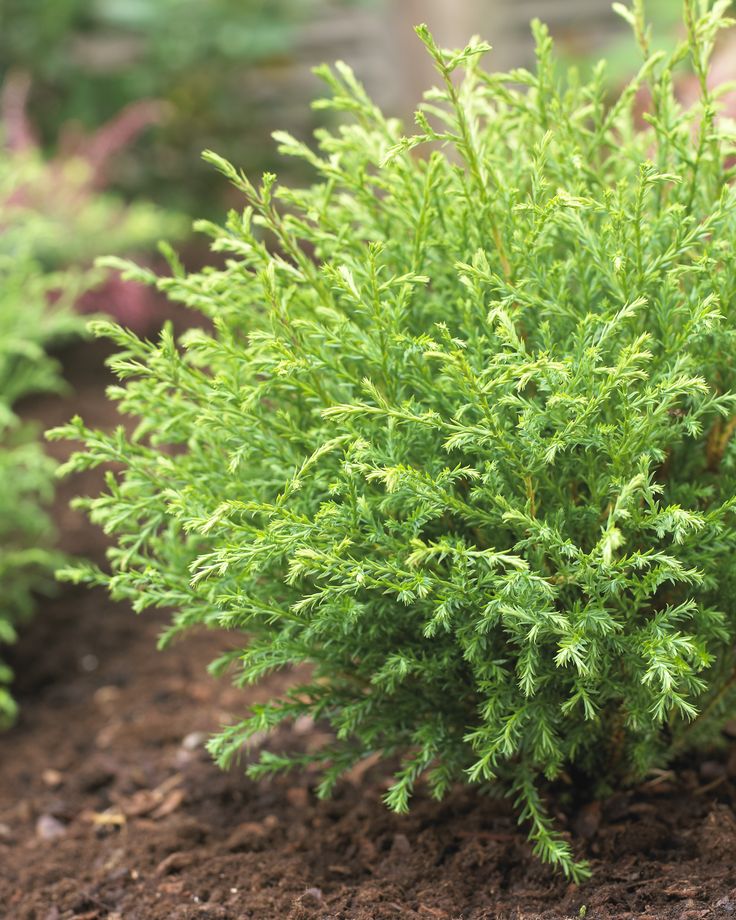 We are talking not only about Russian winters, but also about strong winds, downpours, and hail.
We are talking not only about Russian winters, but also about strong winds, downpours, and hail.
Types of ornamental shrubs
Shrubs are classified according to different criteria. Depending on the height of the plant:
- undersized. The height of these types of shrubs does not exceed a meter. They have a compact shape. An example of such shrubs is the Japanese spirea, juniper;
- medium height. Their height can be from 1.5 to 2.5 meters. An example is common barberry, currant bushes;
- tall. Height over 2.5 meters. An example is lilac, elderberry, hawthorn.
Speaking about the height of shrubs, it should be noted that this classification is relative. Since the height may be different depending on the dressings and their intensity, light, climatic zones, the use of growth stimulants.
Growth classification:
- very fast growing. Shrubs grow up to 3 meters within two or three years. An example is acacia, mock orange;
- moderately fast growing.
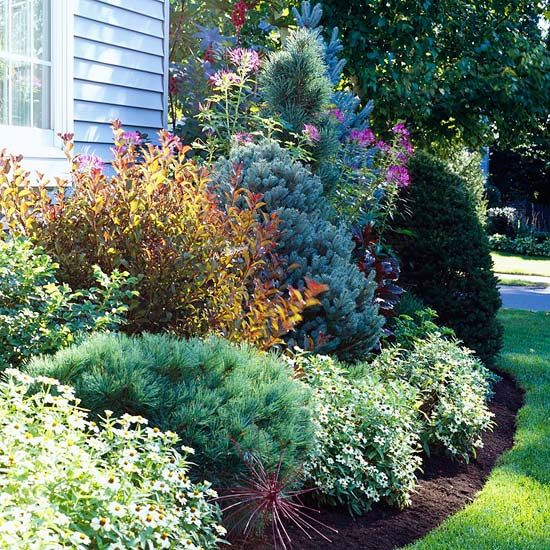 Viburnum ordinary, honeysuckle;
Viburnum ordinary, honeysuckle; - with moderate growth. Cherry, lilac;
- slow growing. An example is sea buckthorn, Cossack juniper;
- very slow growing. An example is coniferous shrubs and deciduous dwarf species.
Lifespan Classification:
- short lifespan - shrub lives less than 25 years. An example is elderberry, meadowsweet;
- with an average term - a shrub lives up to 30 years. An example is currant;
- centenarians - a shrub can grow up to 100 years. An example is common viburnum, lilac;
- with a very long life span of over 100 years. An example is thuja.
Temperature classification:
- very thermophilic. Can die at minus 10 degrees. They are not suitable for central Russia;
- thermophilic. They require shelter, as the above-ground part often dies in the cold;
- moderately thermophilic. Due to the long growing season, they have time to become woody;
- frost-resistant.
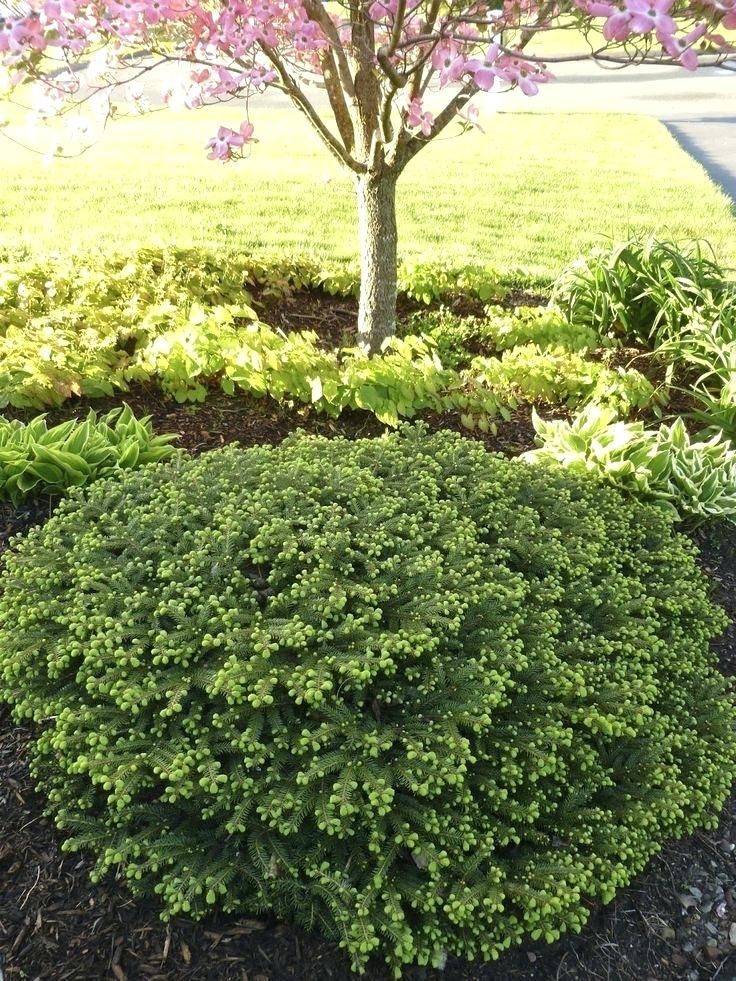 They tolerate cold winters well, but may lose some of the shoots;
They tolerate cold winters well, but may lose some of the shoots; - high frost-resistant. These species can withstand winter cold down to minus 50 degrees. This includes many coniferous shrubs.
So, we have talked about the main species that exist in nature. Now let's talk about which shrubs are best planted in central Russia.
Decorative deciduous shrubs
Not everyone knows about their existence. But it's time to catch up. After all, deciduous varieties are very fond of using landscape designers to decorate plots. They can be deciduous, that is, they shed their leaves during the cold season. They can be evergreen and fluffy.
Varieties of ornamental shrubs with leaves, for the most part, like well-lit places, fertile soil. They do not tolerate frost very well, so they need to be covered for the winter. One of the brightest representatives of deciduous shrubs, which is loved by the inhabitants of our country, is the Japanese maple.
Japanese maple
A beautiful plant with carved large leaves. In autumn, they turn purple-red, which causes a lot of positive emotions. Such shrubs always collect a lot of views. They are hardy and grow fast.
Barberry
Also common in our country. A hardy spreading shrub. It easily tolerates shade, it is not very picky about soils. Barberry has not only thick leaves, but also small red berries, elongated. They are edible and useful. Used for compotes, for drying for the winter.
Aralia
Thermophilic shrub. Loves light, warmth and fertile soil. It has straight large leaves. Good for site decoration.
Fieldfare
In recent years, it has been forgotten, which is completely unfair. The shrub does not require any complex agricultural practices. It grows quickly, has beautiful leaves and flowers. Fieldfare aged looks impressive.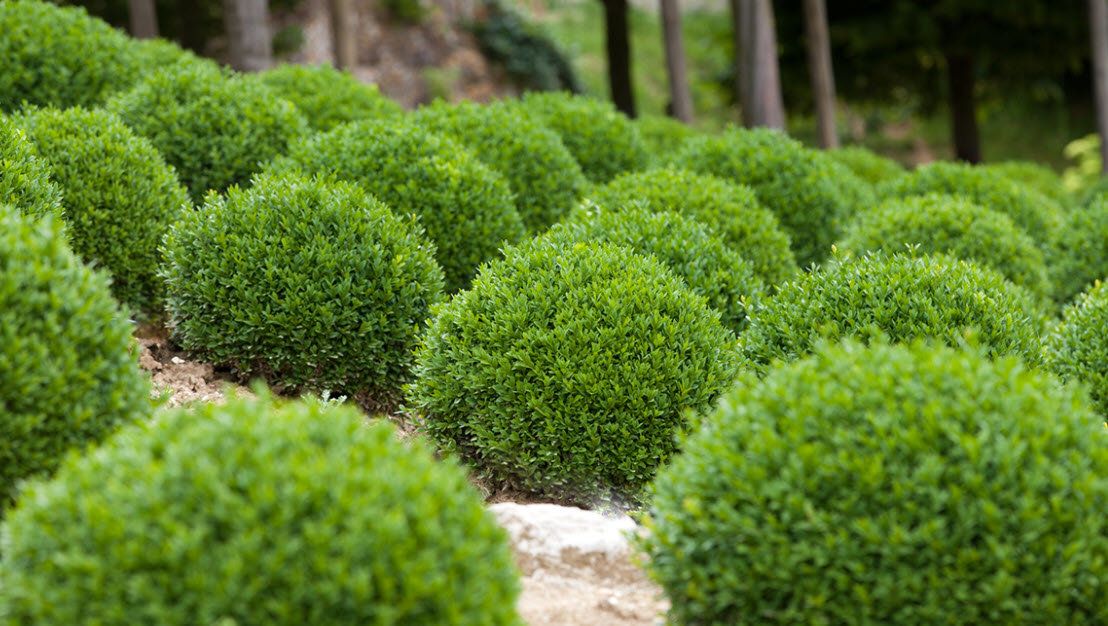 Speaking about the forgotten fieldfare, we must also mention the elderberry, which will also serve as an excellent decoration for the site.
Speaking about the forgotten fieldfare, we must also mention the elderberry, which will also serve as an excellent decoration for the site.
Frost-resistant ornamental flowering shrubs
When it comes to flowering plants, our thoughts immediately come to the idea of beautiful rose bushes, flower beds with an unusually pleasant aroma. But not only flower beds, but also shrubs bloom. They look very advantageous in the garden, filling it with a delicate aroma. But far from all flowering shrubs are suitable for our country, as they can freeze out in winter. Which of them will endure our cold weather?
Lilac
Who does not know this shrub. Lilac is not whimsical, grows rapidly. It can be easily cut off. Grows in both shade and sun. Has different colors and shades.
Spiraea
Very cute shrub that can have pale pink or white flowers. Under its weight, it spreads beautifully on the site. It can be cut to the desired shape. Tolerates frost well.
It can be cut to the desired shape. Tolerates frost well.
Hydrangea
Huge hats of various colors leave no one indifferent. Hydrangea tolerates cold very well. When grown unpretentious.
Rhododendrons
Very beautiful shrubs that can be of different types. They are unpretentious, can grow in marshy places. They tolerate winter well.
There are many ornamental flowering shrubs. You can plant viburnum, jasmine, cinquefoil, buddley, tree peonies on the site. This is a matter of taste and personal preference.
Perennial ornamental shrubs
There is a very wide variety of them. Most often in our country the following varieties of perennials are used.
Japanese quince
Beautiful shrub with interesting flowers. Often used for hedges.
Weigela
This is a favorite plant used in Japanese gardens.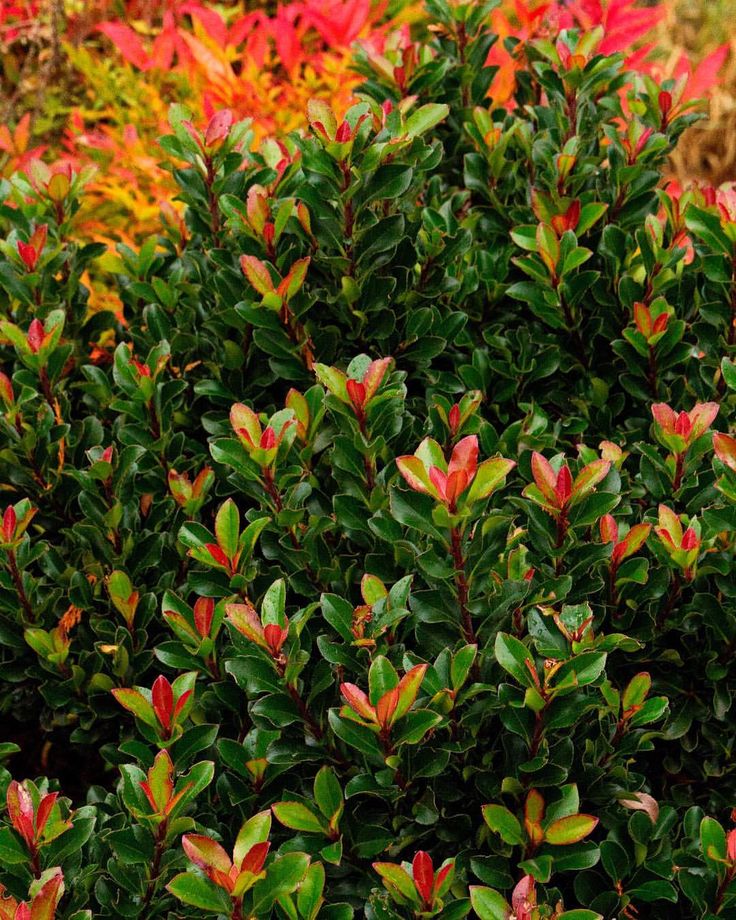 Most often it has pale pink flowers. A sprawling bush that looks very advantageous and spectacular on the site.
Most often it has pale pink flowers. A sprawling bush that looks very advantageous and spectacular on the site.
Jasmine
This beautiful shrub has not only lovely flowers, but also a delicate fragrance. When jasmine blooms, it exudes a scent that fills everything around. Very unpretentious shrub, very popular.
Hibiscus
It is considered to be used for hedges. Hibiscus is in high demand. Plots with it have a very attractive and luxurious look.
Low-growing ornamental shrubs
Low-growing shrubs look very nice on the site, and do not require complex pruning. They are good to use for small gardens or for arranging the lowest level in a flower bed. However, they do not require frequent watering, love the sun.
Heather
Grows in many countries of the world. Used in medicine, unpretentious. Has small flowers. Most often purple or pinkish.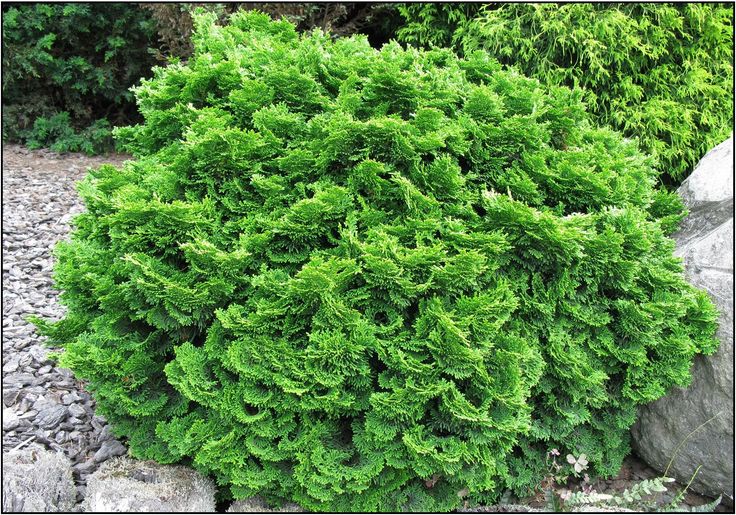 Heather looks great on the site. But in a harsh climate, it is better to cover it for the winter.
Heather looks great on the site. But in a harsh climate, it is better to cover it for the winter.
Polyanthus roses
Roses are roses. They are always the prettiest. At the same time, it is these roses that are unpretentious, bloom all season until the cold weather, and do not require complex care. The height is usually not more than 50-60 cm. Flowers are about 3 cm in diameter. Looks good on the site, easily tolerates pruning. There are different types.
Spiraea can also be referred to undersized varieties. We talked about it above.
Evergreen ornamental shrubs
We all know from childhood that a Christmas tree is green in both winter and summer. But it is large. The bottom line here is that evergreen shrubs are also conifers. This is, for example, juniper. But there may be other evergreen shrubs, such as rhododendron, heather, boxwood, holly.
As you can see, there is a wide variety of shrubs.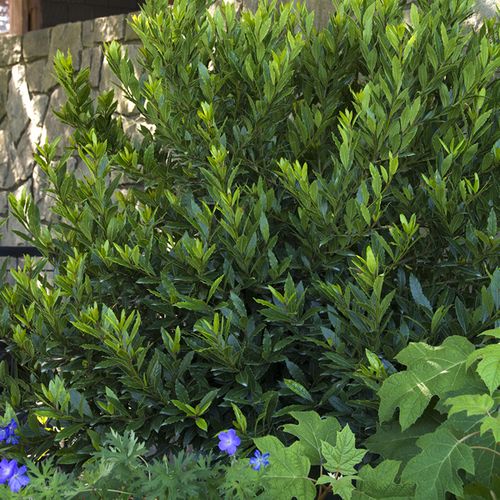 Each of them is beautiful in its own way. Do not be afraid to experiment, plant different varieties, read about them, observe.
Each of them is beautiful in its own way. Do not be afraid to experiment, plant different varieties, read about them, observe.
Evergreen shrubs photo with names
In the article we will talk about the most popular and common types of shrubs with photos and names among summer residents.
Russian name for strawberry tree, strawberry.
A slow-growing shrub that has hanging flowers and strawberry-like fruits
at the same time on the plant at the end of autumn - these fruits are tasteless.
The popular large-fruited strawberry reaches a height of 2 m.
Its flowers are white. Flowering time: October - December
Blooms in June, loves full sun.
The plant is hardy, able to endure winter frosts in many regions, but requires protection from gusts of icy winds.
Huge inflorescences are formed at the beginning of summer, individual specimens grow up to three meters in height, leaf width up to one meter.
Holly mahonia is an ornamental evergreen shrub up to 4 m high.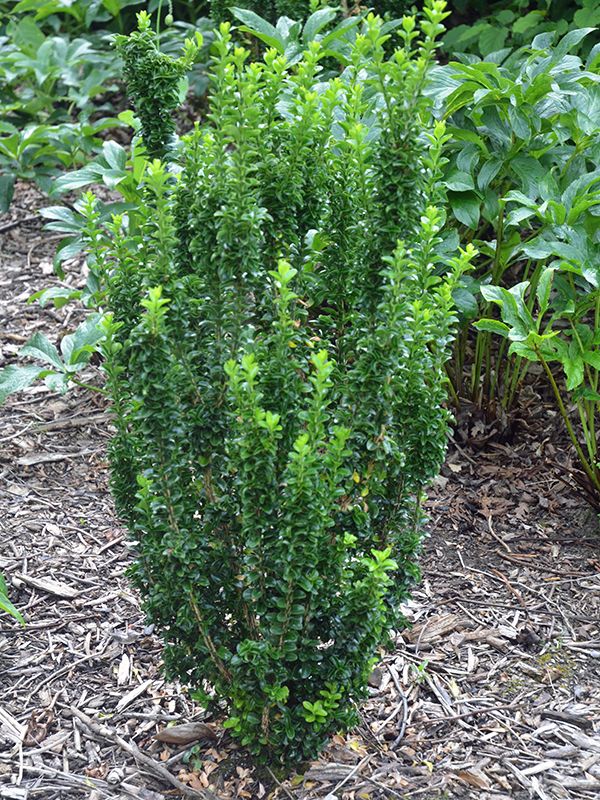
This plant grows best in shade or partial shade.
Young mahonia leaves are orange-green in color, which becomes dark copper in winter.
Tolerates cold well, propagated by seeds.
This shrub blooms very beautifully with small yellow flowers collected in caps.
Many sources attribute this species to the genus Barberry under the name Berberis aquifolium
A symbol of Christmas, it is with it that houses are traditionally decorated during the winter holidays.
Holly is an evergreen shrub that blooms from October to December, easily tolerates shading, but it is not a shade-loving plant.
The greatest contrast of colors in this plant appears in the sun.
Holly is especially beautiful in winter, when bushes with bright green leaves and
beads of red, white, yellow, black and orange berries stand out on the snow, which remain on the bushes all winter.
This is a branched, low evergreen shrub with small, dense and narrow green leaves.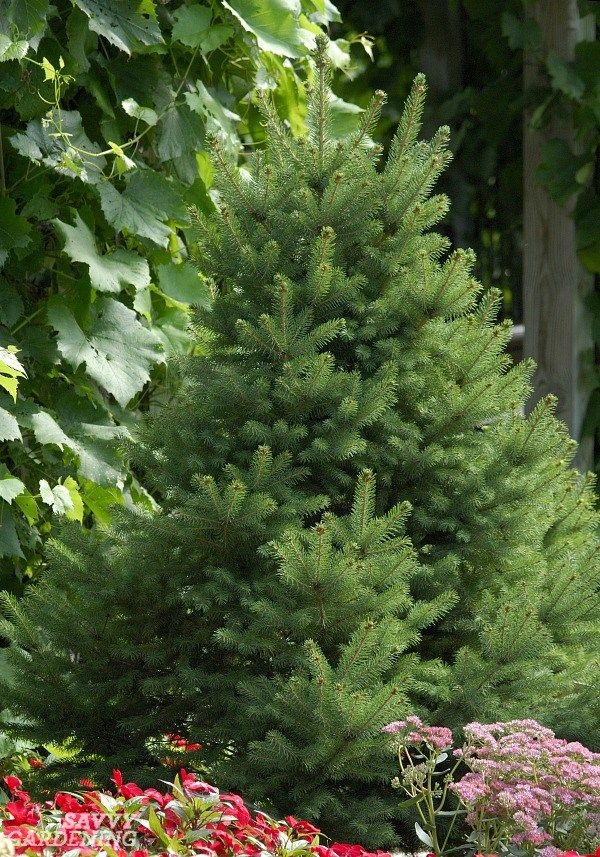
The plant is very fond of light and blooms with white flowers in the month of May.
Photo of Iberis
An evergreen shrub with dense glossy dark green foliage.
Blossoms unusually beautiful, forming inflorescences similar to roses.
Photo of Camellia
But the value of this evergreen shrub is that its flowering begins ... in autumn and lasts up to three months.
Boxwood withstands wind, alkaline soils and some shade.
Stems can be cut regularly.
Boxwood evergreen shrub will grow to 3m if left unpruned.
Boxwood variety 'Aureovariegata' has yellow spotted leaves; "Suffruticosa" - dwarf.
Propagated by cuttings under glass in summer.
Russian names for boxwood - boxwood, green tree, gevan, bukshpan, shamshit
Shuaziya - a rounded evergreen shrub has a densely leafy crown all year round.
Flat inflorescences of wax flowers appear in spring - both leaves and flowers are fragrant.
Photo of Choisia
Choisia trifoliate - 2 m high.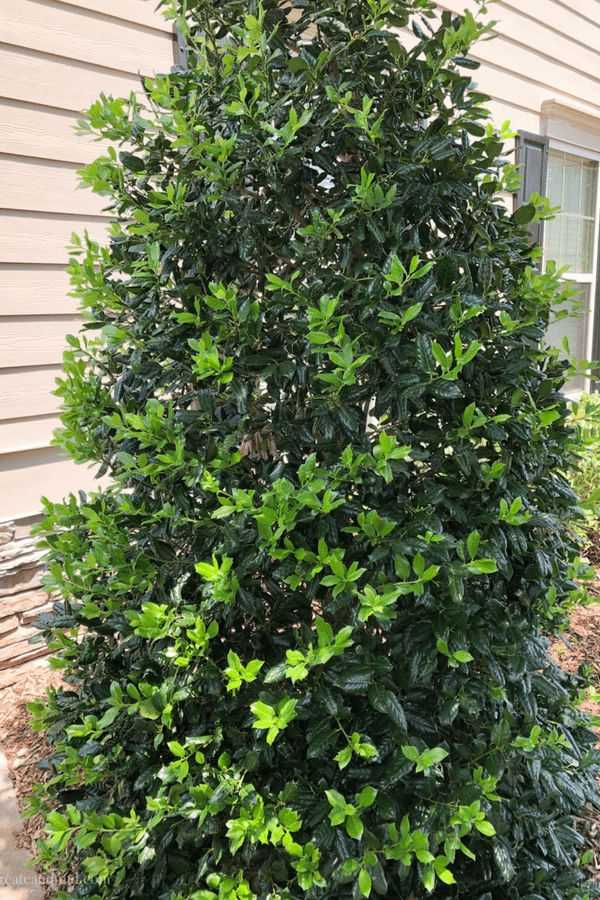 Flowering time: April - May.
Flowering time: April - May.
Location: sunny or slightly shady.
Reproduction: cuttings under glass in summer.
Callistemon blooms in the first two summer months.
It is recommended to plant in places well lit by the sun.
Propagated by cuttings planted in the summer under a glass canopy.
Flowering is small, stamens are produced in densely collected cylindrical inflorescences.
Usually planted on the sun-facing side of the plot.
Dark pink flowers, long leaves.
The height of lemon-yellow callistemon can reach two meters, and hard callistemon - only one and a half meters, but it is famous for its endurance.
Winter garden with evergreens
In winter, the garden can be green and beautiful with evergreen shrubs and
trees that retain their foliage and color on cold days.
Some retain fruit.
Photinia is a perennial evergreen plant.
Very easy to grow as a short tree or shrub up to 2 m.
Fast growing, making it one of the most preferred hedge plants.
The leaves are shiny, dark green, but during the autumn season they turn a bright red hue.
Blossoms in May-June with tiny white flowers that turn into bright red fruits.
Photonia loves sunny places and moist soils.
Resistant to temperatures down to -15 C.
In severe frosts, the roots must be well protected.
Can be planted both individually and in groups.
Holly holly — Ileks can be grown as a small tree or shrub up to 3 m, its leaves remain green all year round.
It blooms with small white flowers, the berries are bright red.
The beautiful contrast between foliage, flowers and fruits makes holly a very attractive garden plant.
Shrub can withstand temperatures down to -20 C. Can grow in shady places, loves moisture.
Often used to make Christmas wreaths.
Cherry laurel is an evergreen shrub of high ornamental value.
It reaches a height of up to 2 m, has dark green leaves and white flowers.
Likes shady places and moist soil.
Propagated by seeds and cuttings in summer or autumn.
Laurel can be planted both individually and in groups, and can also be used for hedges.
In the photo there are laurel cherry flowers
Japanese Euonymus is a deciduous evergreen shrub that can reach up to 5 m in height.
Likes shade and cold, very unpretentious, needs moderate watering, blooms in spring.
It is planted alone or used as a complement to the composition.
It develops well in all types of soil and tolerates pruning very well.
Prickly goof (prickly goof) is an evergreen representative of the fragrant willow, has a height of about 3 m.
The leaves are glossy, dark green on the upper side and silvery on the underside.
Blooms in autumn - early November. Mainly used for hedges.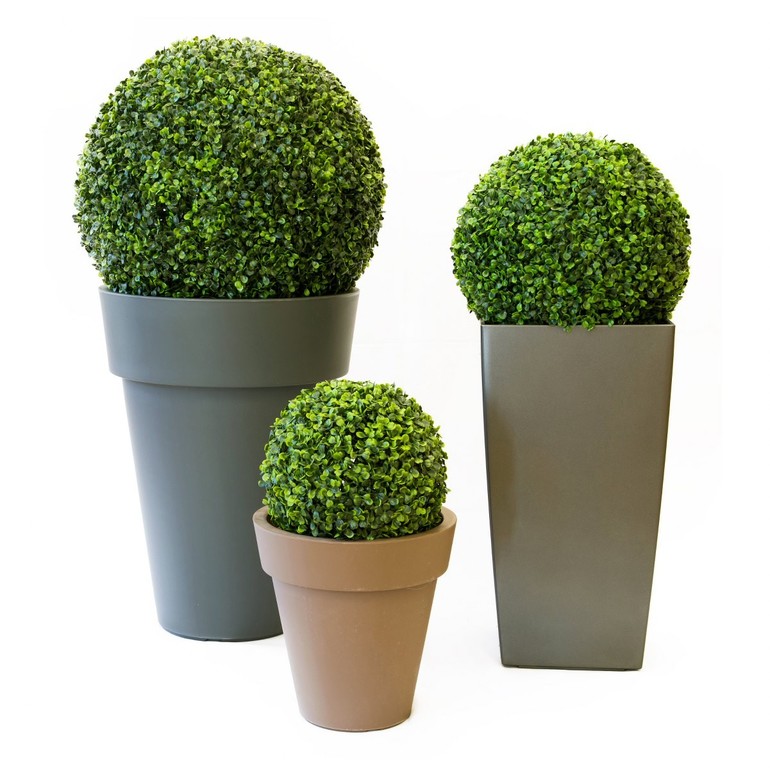
Excellent growth and excellent resistance to cold and drought.
Juliana barberry is a cold and unassuming plant.
Tolerates both sun and drought.
Photo of barberry
It develops well on any soil.
Very suitable for hedges.
Japanese Akuba (Aucuba japonica) is a simple plant with high ornamental value,
which can be enjoyed throughout the year.
Likes shade or partial shade. Blooms in March-April.
Pontian rhododendron is an evergreen shrub up to 5 m high.
The leaves are large, glossy green.
Blooms in May and June in purplish pink.
He likes a fresh and nutritious soil with good drainage properties.
Lesser periwinkle is an evergreen herbaceous plant.
Blooms with blue or purple flowers, loves shade.
It is also used as a lawn.
Evergreen shrubs for the garden: what to choose
it is difficult if the image of your unique garden is formed not only by ordinary, but also by evergreens. Of course, when choosing ornamental shrubs for the site, you need to focus on a number of important factors. But the main thing is the task that the shrubs must perform: a decorative fence for the patio area, a living wall on the border of the neighboring plot, framing the garden path or part of the country landscape, presented in garden planters. We have selected for you the 10 best evergreen shrubs for the garden, which will be good in different climatic zones.
Of course, when choosing ornamental shrubs for the site, you need to focus on a number of important factors. But the main thing is the task that the shrubs must perform: a decorative fence for the patio area, a living wall on the border of the neighboring plot, framing the garden path or part of the country landscape, presented in garden planters. We have selected for you the 10 best evergreen shrubs for the garden, which will be good in different climatic zones.
Evergreen shrub for summer cottages: holly mahonia
This interesting plant will decorate your garden all year round and bloom fantastically in spring. It should be noted that the fruits of mahonia - not only beautiful, but also useful - have antibacterial and anti-inflammatory properties.
Ornamental shrubs for the garden: aucuba
Beautiful and not too capricious exotic aucuba will grow anywhere. The main thing is to hide it from the icy winds. The height of the Japanese aukuba is about two meters.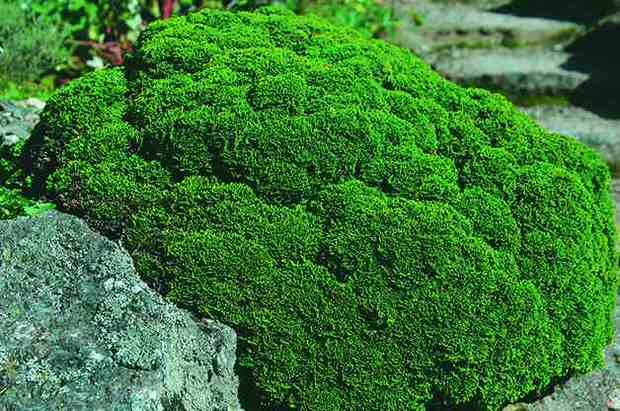 The shrub loves sunny and semi-shady areas. The plant belongs to the poisonous flora, so think carefully about whether to plant it on the site if you have children.
The shrub loves sunny and semi-shady areas. The plant belongs to the poisonous flora, so think carefully about whether to plant it on the site if you have children.
Shrubs for cottages - which are better: strawberry tree
This plant is characterized by slow growth, the presence of tasteless fruits, similar to large strawberries. Fragrant arbutus (strawberry) blooms all autumn, reaches a height of two meters.
Beautiful shrubs for the garden: callistemon
An amazing plant from the myrtle family, known for its brush inflorescences, similar to bright pipidastras. The shrub that blooms in the summer months is also called "Bengal candles". In addition to the "brushes" on the shoots, it is famous for its fragrant foliage and record adaptation to any conditions.
Garden Shrubs: Boxwood
Also called Buxus, boxwood is good in the garden landscape for both hedges and solos.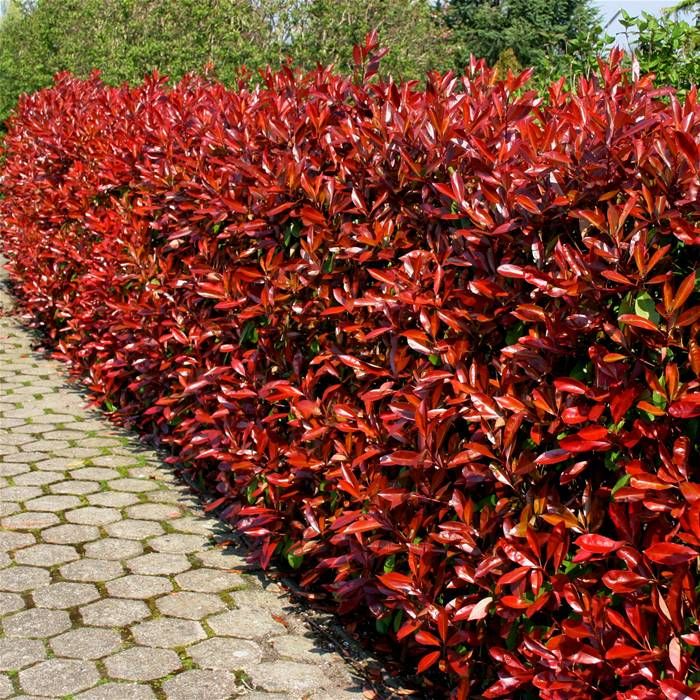 Previously considered obsolete, today it is gradually returning to our gardens. Boxwood is resistant to winds, shading and alkaline soil.
Previously considered obsolete, today it is gradually returning to our gardens. Boxwood is resistant to winds, shading and alkaline soil.
Editor's note:
— Despite the fact that there are fewer evergreen shrubs than those traditionally used in gardening, today their choice is wide enough to pick up green "pets" for your unique garden. Before buying seedlings, carefully choose a place for shrubs and study their character. You should proceed not only from your wishes and the style of the garden landscape, but also from the degree of illumination, the type of soil and the size of the plot, climatic features, frost resistance and capriciousness of plants. Some are able to grow according to the principle “I stuck a stick in, the next day it was spiked”, while others begin to wither even from the wind and excess sun.
Climbing shrub: evergreen honeysuckle
One of the most winter-hardy varieties of evergreen honeysuckle is Blanche Sandman. A climbing beautiful plant with a delicate aroma fits into the design of any garden and easily tolerates harsh winters.
A climbing beautiful plant with a delicate aroma fits into the design of any garden and easily tolerates harsh winters.
Evergreens for the garden: photos and names
Evergreens are decorative all year round. First of all, these are conifers, in summer they effectively emphasize the beauty of the surrounding flowers, and in winter they solemnly turn green against the background of white snow. But we decided to talk about deciduous, mostly of southern origin, which are also very popular in landscape design. We offer an overview of interesting types of evergreens for the garden with photos, names and brief descriptions, ideas for creating compositions with their participation.
Evergreen perennials are represented by all life forms: trees, shrubs, shrubs, shrubs, herbaceous plants.
Trees
Trees, which retain their decorative effect all year round, are planted on the site both singly and in groups, create hedges, and make the main accent in the mixborder.
Berry yew
Berry yew belongs to the class Coniferous, family Yew. It grows up to 20 m in height, although this will take more than one century. Unlike conifers, it does not have cones, but seeds surrounded by a fleshy, juicy red shell, similar to berries. Therefore, it is also called "mahogany".
Relic trees are common in the Caucasus, the Black Sea coast. In culture, shrub forms are more often used.
Interesting varieties with an unusual color of needles. For example, "David" (bright green), "Summergold", "Cooper Gold" (yellow), "Elengatissima" (light green, cream). All of them are suitable for growing in the middle lane.
Boxwood
Boxwood occurs in tree and shrub form, about 30 varieties are known. Trees can grow up to 12-15 m. These are also ancient, relict plants, forming in nature, together with yew, large yew-boxwood groves. Boxwood has leathery, oblong leaves arranged oppositely on the stem. Small inconspicuous flowers emit a strong aroma.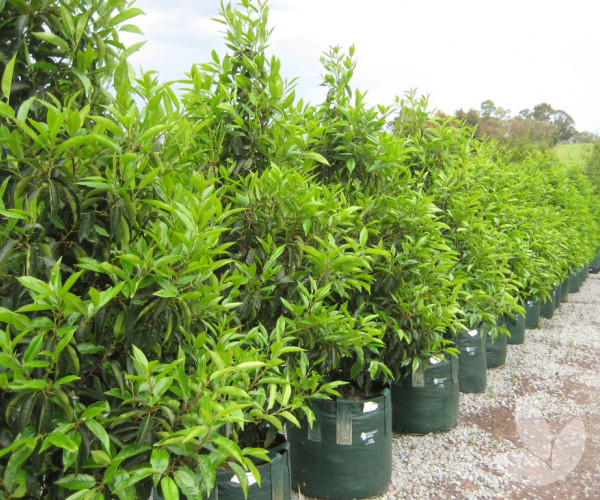 The wood is very dense and heavy.
The wood is very dense and heavy.
Variegated species are interesting, for example, evergreen boxwood "Variegata" (pictured).
Holly
Holly (holly) belongs to the genus of trees and shrubs of the Holly family, growing in temperate and tropical climates. In the natural environment, the trees reach 10-20 m. The leaves of the holly are beautiful, shiny, carved, dark green or two-tone in color; may have spikes. Bright berries (drupe fruit) of red, orange, yellow, white, or black often persist on branches throughout the winter.
Holly is unpretentious in care, but loves fertile soils, reacts to fertilization with abundant foliage and flowering, responds well to formative pruning. When planting in the garden, a good company for the holly will be hydrangea, mahonia, cypress, euonymus.
Shrubs
Most evergreen shrubs are not adapted to harsh winters and require shelter.
An overview of varieties suitable for cultivation in temperate climates is given in the table:
Like all kinds of euonymus, it is valued for the decorative color of the leaves. This is a creeping, creeping form. It is widely used as a ground cover under trees, in rock gardens. Needs shelter in winters with little snow
This is a creeping, creeping form. It is widely used as a ground cover under trees, in rock gardens. Needs shelter in winters with little snow
Canadale Gold with yellow-edged leaves;
Minimus - forms a low green carpet, ideal for alpine slides and rockeries;
Blondy - green leaves with a large cream spot in the middle, grown as a vine, as a ground cover, in container culture
A relative of the lilac, belongs to the Olive family. About 50 varieties are known, but in central Russia only 2 varieties of common byrichina have successfully spread. It is best suited for creating hedges. Well propagated by cuttings. Likes sunny places, drought-resistant
Aureum - 0.8-1 m high, has golden foliage, does not bloom;
Atrovirens - dark green leaves in summer, purple-brown in autumn, blooms in white panicles
Non-thorny berry shrub from the Rosaceae family. Notable for its dark foliage that turns red in autumn. Flowers inconspicuous, white or pink. Berries are red or black. Cotoneaster hedges often decorate city streets
Berries are red or black. Cotoneaster hedges often decorate city streets
Among the most frost-resistant varieties: shiny, entire, chokeberry
Squat, up to 1 m, shrub of the Barberry family. The leaves are leathery, dry, with teeth. It blooms with bright yellow flowers, in place of which bluish berries are formed. By autumn, the bush turns red. Groups and borders are usually made from mahonia
Fruit varieties: "Sweet", "Mermaid", "Timoshka".
"Smaragd" - with lush bright yellow inflorescences;
"Dureya" - distinguished by yellow-green foliage;
"Compacta" - up to 50-70 cm high
Beautiful flowering shrub of the Heather family with various colors of corymbose or panicle-shaped inflorescences. Prefers places protected from the wind, diffused light. Demanding on soil fertility, needs abundant watering
Good winter tolerance: Japanese, Dahurian, Canadian, Katevbinsky
Many shrubs, as noted above, are excellent for forming hedges.
Dwarf
Due to their compactness, beauty of flowering, aroma, low shrubs, semi-shrubs and shrubs have earned the well-deserved respect of professionals and flower growers who strive to make their garden unusual, modern, stylish.
Lavender angustifolia
An essential oil crop from the Lamiaceae family is grown commercially and in gardens around the world. Lavender is well propagated by seeds. In regions with a mild climate, winter sowing is practiced.
Flower growers of the middle zone stratify seeds before planting for two months on the bottom shelf of the refrigerator, sown for seedlings in February - March.
Heather
Rock gardens, rocky gardens are often decorated with evergreen shrubs from the Heather family. Of these, if desired, you can create whole heather glades that will bloom from spring to autumn.
Erica is a relative of heather, differing from it in its flowering time, which begins in spring, and needle-shaped leaves.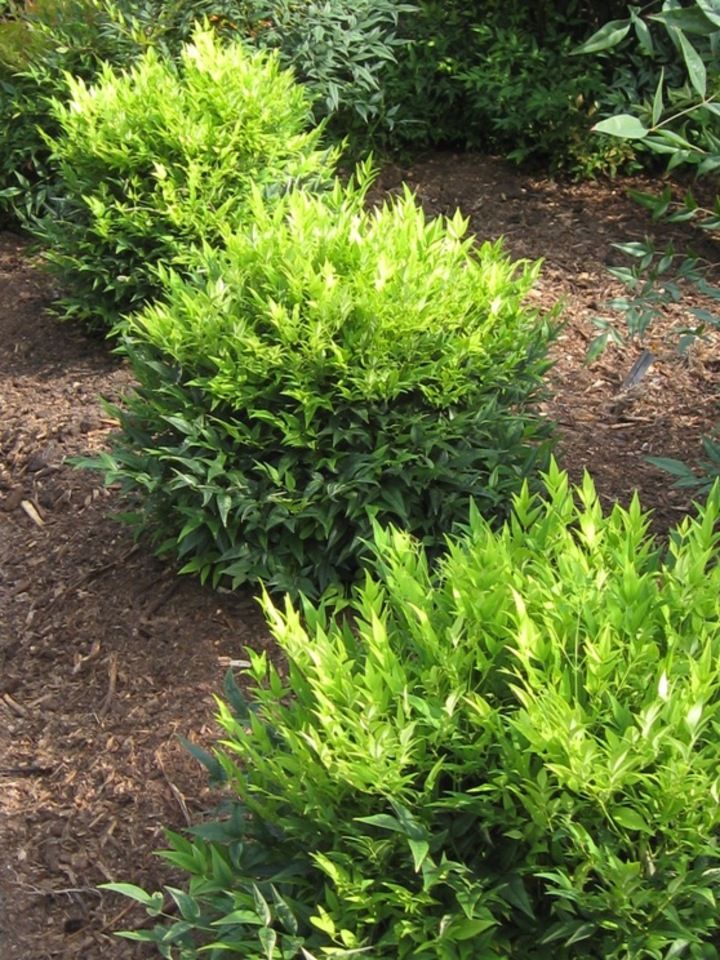 Heather blooms in late summer - autumn and has more scaly leaves.
Heather blooms in late summer - autumn and has more scaly leaves.
The lower tier of flower beds and alpine hills are a great place for common podbel . Its second name is Andromeda. The plant is poisonous, so you need to work with it very carefully.
Groundcovers
Perennial evergreen groundcovers are not only permanent residents of rocky gardens, slopes and flowerbeds decorated with stones. They are planted in the forefront of ordinary flower beds, sometimes used as a lawn, decorated with tree trunks of fruit and ornamental trees, shrubs, settled on poor, sandy soils. All of them are very unpretentious, have the ability to grow quickly and fill the space. Forming a thick carpet or dense pillows, such plants give the landscape a forest color (periwinkle, tenacious) or imitate the atmosphere inherent in mountain landscapes (antennaria, bryozoan). In addition, they help control the growth of weeds.
Antennaria
Very attractive due to the felt, silvery pubescence of foliage, soft, pretty inflorescences, thanks to which it received the popular name "cat's paw".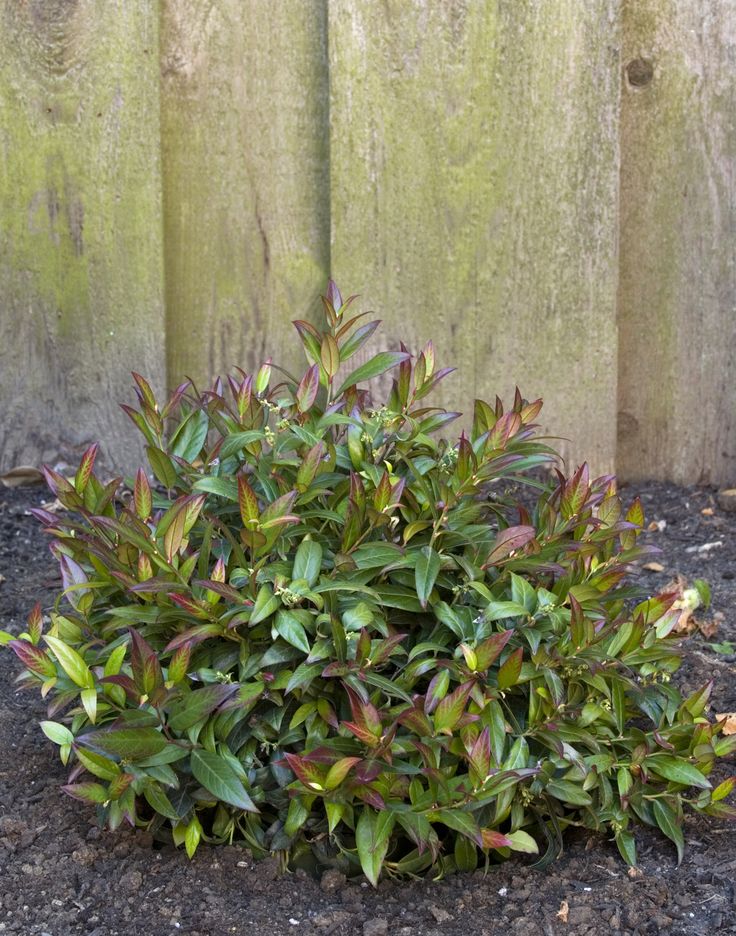 Belongs to the Compositae (Asteraceae) family. In nature, it grows in mountainous areas, pine forests.
Belongs to the Compositae (Asteraceae) family. In nature, it grows in mountainous areas, pine forests.
Lesser Periwinkle
Surprisingly viable plant from the Kutrovye family. Due to the high content of alkaloids, it is poisonous, but, nevertheless, it is very much appreciated by gardeners for its unpretentiousness, shade tolerance, the beauty of the dark green carpet formed and rather large, often blue hues, flowers.
Creeping tenacious
Creeping tenacious (auyuga) from the Lamiaceae family attracts attention not only by the beauty of the inflorescences, but also by the decorativeness of the leaves, which is also affected by the degree of illumination. Greenish-cream, burgundy, pinkish, purple-violet, with spots and stains ... The tenacious is often planted in flowerbeds, alpine slides, where it fills well the voids between the stones, along the paths.
Styloid bryozoan
Miniature grass, up to 8 cm high, from the Carnation family. From the end of spring it is covered with small snow-white flowers, which continue to appear until autumn.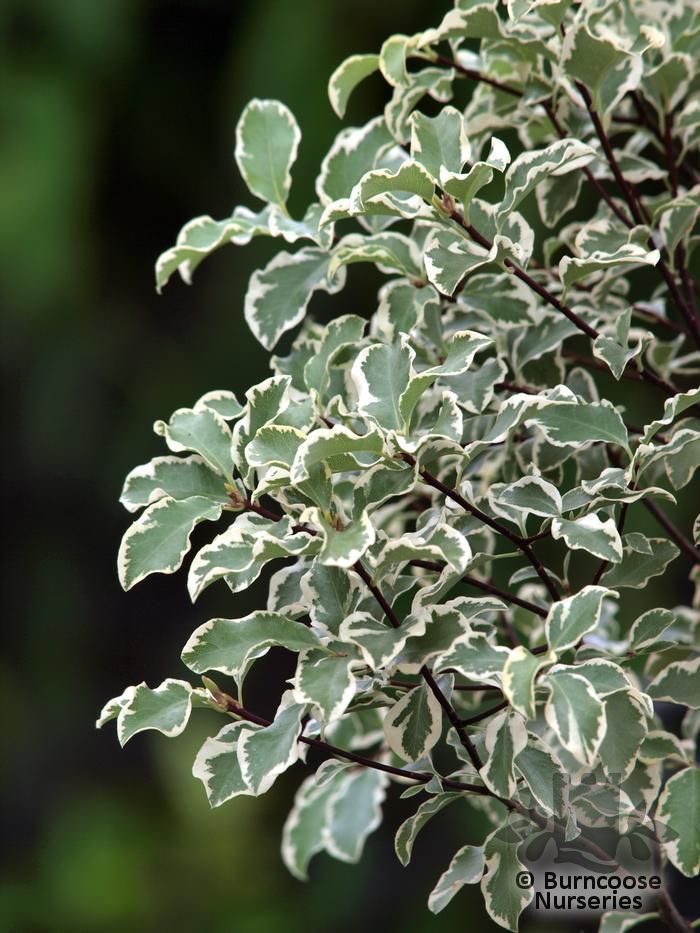 Forms dense cushions. It is placed in rocky gardens, used as an element of borders, as a lawn cover.
Forms dense cushions. It is placed in rocky gardens, used as an element of borders, as a lawn cover.
Video
Useful tips on choosing evergreens for decorating garden plots in different regions are shared by specialists and experienced flower growers in the following videos:
honors). For 15 years she worked as an editor-in-chief in a weekly regional newspaper. He knows firsthand how to raise chickens, rabbits, piglets (my parents kept a small farm). Today he is fond of indoor, balcony and garden floriculture. It is a strict taboo for purchased seedlings: she grows it herself, and shares the surplus with colleagues and friends. He loves the time of harvesting and harvesting and forest gifts. And he still cannot imagine his life without dogs, cats and books. Natalia enjoys learning and sharing her knowledge and experience with readers.
Found a mistake? Select the text with the mouse and click:
Compost is rotted organic residues of various origins.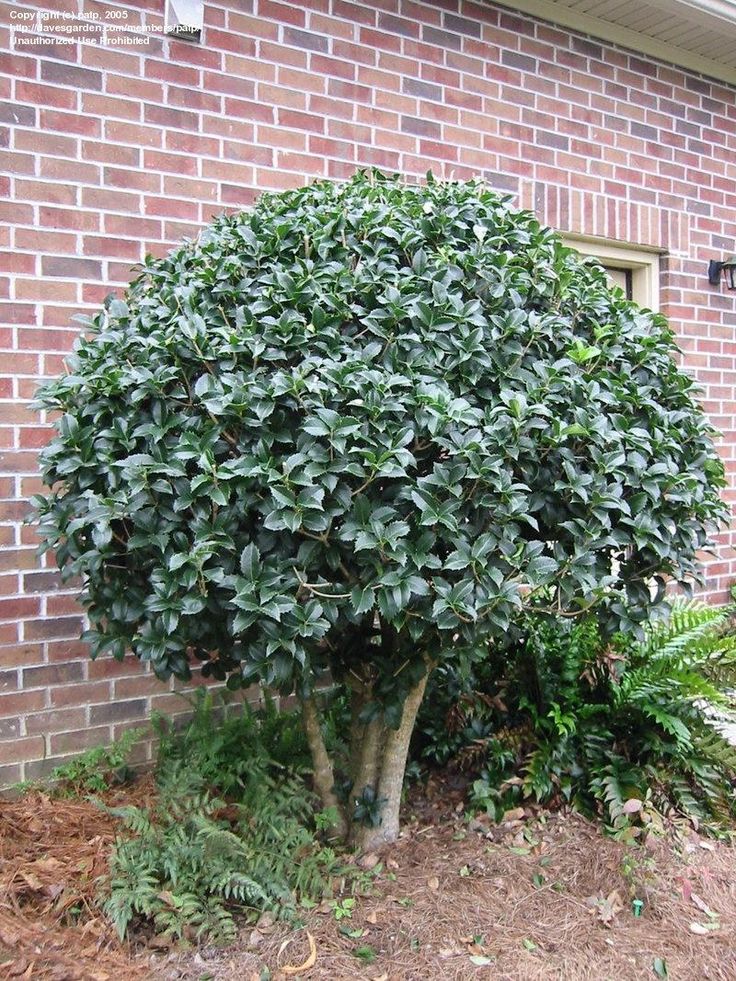 How to do? Everything is put in a pile, a pit or a large box: kitchen leftovers, tops of garden crops, weeds mowed before flowering, thin twigs. All this is interbedded with phosphorite flour, sometimes straw, earth or peat. (Some summer residents add special composting accelerators.) Cover with foil. In the process of overheating, the pile is periodically stirred or pierced to bring in fresh air. Usually compost "ripens" for 2 years, but with modern additives it can be ready in one summer season.
How to do? Everything is put in a pile, a pit or a large box: kitchen leftovers, tops of garden crops, weeds mowed before flowering, thin twigs. All this is interbedded with phosphorite flour, sometimes straw, earth or peat. (Some summer residents add special composting accelerators.) Cover with foil. In the process of overheating, the pile is periodically stirred or pierced to bring in fresh air. Usually compost "ripens" for 2 years, but with modern additives it can be ready in one summer season.
Tomatoes have no natural protection against late blight. If late blight attacks, any tomatoes die (and potatoes too), no matter what is said in the description of the varieties (“late blight-resistant varieties” is just a marketing ploy).
"Frost-resistant" varieties of garden strawberries (more often simply "strawberries") need shelter just like ordinary varieties (especially in those regions where there are snowless winters or frosts alternating with thaws). All strawberries have superficial roots.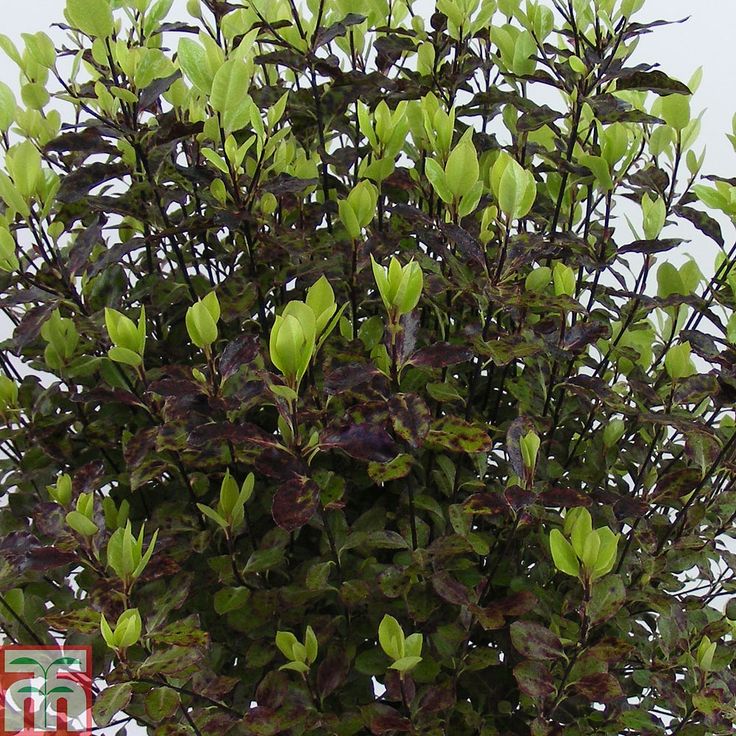 This means that without shelter, they freeze out. Assurances of sellers that strawberries are “frost-resistant”, “winter-hardy”, “tolerate frosts down to -35 ℃”, etc. are a lie. Gardeners should remember that no one has yet been able to change the root system of strawberries.
This means that without shelter, they freeze out. Assurances of sellers that strawberries are “frost-resistant”, “winter-hardy”, “tolerate frosts down to -35 ℃”, etc. are a lie. Gardeners should remember that no one has yet been able to change the root system of strawberries.
Medicinal flowers and inflorescences should be collected at the very beginning of the flowering period, when the content of useful substances in them is highest. The flowers are supposed to be torn by hand, breaking off the rough pedicels. Dry the collected flowers and herbs, scattering in a thin layer, in a cool room at natural temperature without access to direct sunlight.
In small Denmark, any piece of land is a very expensive pleasure. Therefore, local gardeners have adapted to grow fresh vegetables in buckets, large bags, foam boxes filled with a special earthen mixture. Such agrotechnical methods allow you to get a crop even at home.
Freezing is one of the most convenient methods for harvesting grown vegetables, fruits and berries. Some believe that freezing leads to the loss of nutritional and beneficial properties of plant foods. As a result of the research, scientists have found that there is practically no decrease in nutritional value during freezing.
Some believe that freezing leads to the loss of nutritional and beneficial properties of plant foods. As a result of the research, scientists have found that there is practically no decrease in nutritional value during freezing.
Muck - rotted manure or bird droppings. It is prepared like this: manure is piled in a heap or pile, interbedded with sawdust, peat and garden soil. The collar is covered with a film to stabilize the temperature and humidity (this is necessary to increase the activity of microorganisms). Fertilizer "ripens" within 2-5 years - depending on external conditions and the composition of the feedstock. The output is a loose homogeneous mass with a pleasant smell of fresh earth.
In Australia, scientists have begun cloning experiments on several cold-weather grape varieties. Climate warming, which is predicted for the next 50 years, will lead to their disappearance. Australian varieties have excellent characteristics for winemaking and are not susceptible to diseases common in Europe and America.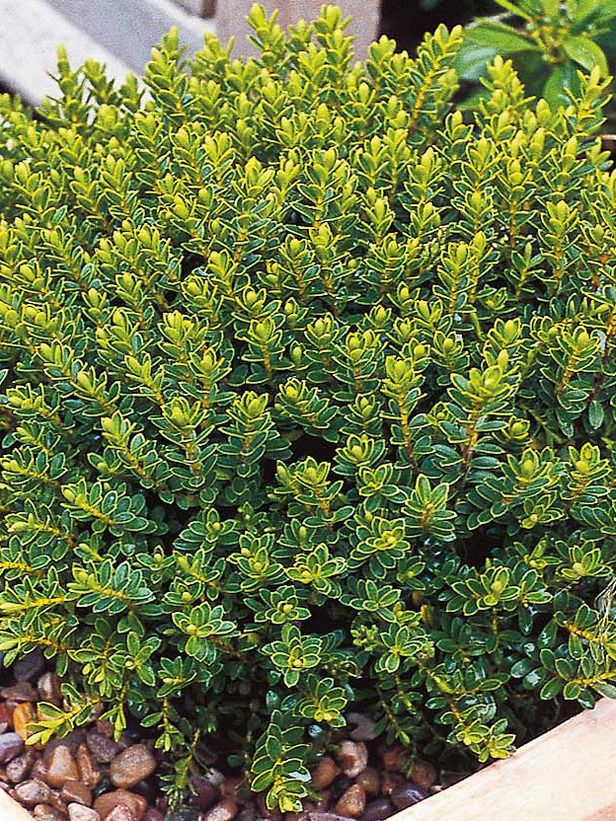
Oklahoma farmer Carl Burns developed an unusual variety of colorful corn called Rainbow Corn. The grains on each cob are of different colors and shades: brown, pink, purple, blue, green, etc. This result was achieved through many years of selection of the most colored ordinary varieties and their crossing.
Beauty all year round. Evergreen ornamental shrubs that can decorate any garden
Good afternoon, dear friends, gardeners and gardeners! I welcome you to the website of the channel "Country Stories".
There are only two colors in the winter garden: the white color of snow and the brown color of tree trunks and shrubs. For several months, there is nothing to catch the eye. Experienced gardeners take this into account, deliberately leaving dry perennial stems with interestingly shaped inflorescences, ornamental grasses, and cereals uncut. They add at least some dynamics to the peaceful picture, swaying in the wind.
In order to keep the garden and plot attractive even in winter, evergreen conifers are planted, fortunately, their choice is now huge: arborvitae, junipers, cypresses, dwarf spruces, mountain pines, etc.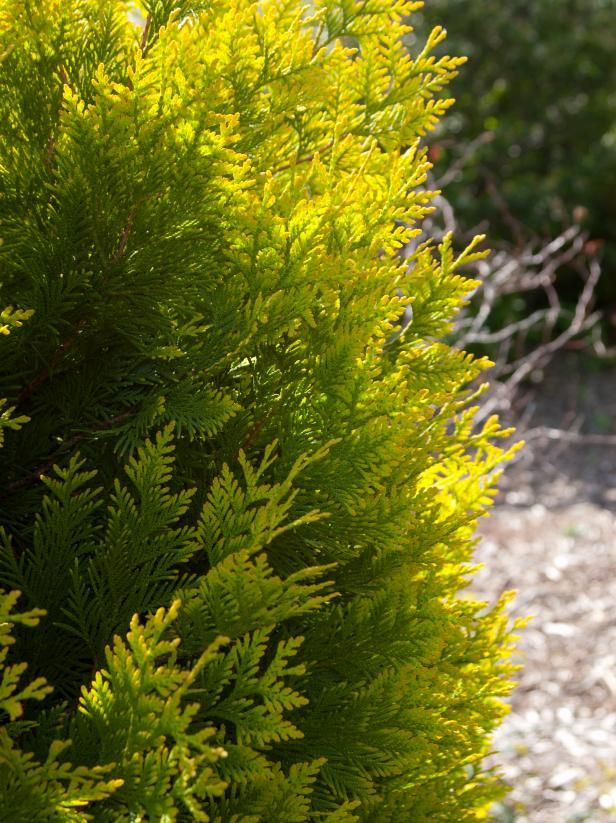 But there are a number of deciduous crops that are not deciduous. Throughout the year they remain green, the change of leaves is gradual, imperceptible to the eye.
But there are a number of deciduous crops that are not deciduous. Throughout the year they remain green, the change of leaves is gradual, imperceptible to the eye.
Evergreen deciduous shrubs are highly ornamental not only because of the dense, often glossy, leaves. Many of them bloom, sometimes profusely, and some bear fruit. Such shrubs will decorate any winter garden. Of course, most of them endure only a mild southern winter, in which the temperature does not fall below -10 ° C, but there are also frost-resistant species.
Rhododendron
In nature, there are many types of rhododendrons, from dwarf shrubs not exceeding 30 cm to trees 2 meters or more in height. The name of the shrub was formed from two Greek words: "rose" and "tree".
These shrubs have dense dark green leaves that persist throughout the year. And with the advent of spring, rhododendrons are covered with lush caps of inflorescences. Rhododendrons are rich in a variety of flower colors: snow-white, pink, scarlet, lilac, lilac, purple, there are varieties with yellow flowers.
Rhododendron is a child of mountains. Under natural conditions, it lives in the Caucasus Mountains, in the Altai Mountains, in the Far East. Rhododendron is not afraid of sudden changes in temperature. Some species are able to withstand frosts down to -20°C.
But for the successful cultivation of rhododendron, you need to create special conditions. In nature, it grows in forests, often coniferous, where the soil is constantly moist and acidic due to coniferous litter. Rhododendrons do not tolerate bright sun, they need shading. If you can find a place protected from the sun on the site, add acidifying components to the soil: coniferous litter, sawdust, peat, etc., then this handsome man will delight not only you, but also your children, because rhododendrons live a very long time.
Varieties and hybrids of Katevbinsky rhododendron are frost-resistant.
- "English Roseum" - a tall shrub (180-240 cm) with purple flowers is not afraid of frost, rain or bright sun.

- "Nova Zembla" - a tall shrub (180-240 cm) with bright pink flowers collected in lush brushes endures both frost and heat.
- "Roseum Elegance" - tall shrub (160-210 cm) with lush lavender inflorescences.
Evergreen boxwood
Evergreen boxwood, even by its name, declares that it is ready to please us with its greenery all year round. But, unfortunately, boxwoods love a warm winter. They are able to tolerate short-term small frosts, but with prolonged frosts below -10 ° C, boxwood freezes out and does not recover. In the conditions of the middle lane, only rare varieties of boxwood can survive, and even then only with very good care and shelter for the winter.
Boxwood is loved by landscape designers because it lends itself well to topiary cutting, allowing you to create complex, original compositions. Boxwood topiary maintains its shape for a long time due to the extremely slow growth of the shrub. Annual growths do not exceed 10 cm, and, on average, are 2-3 cm.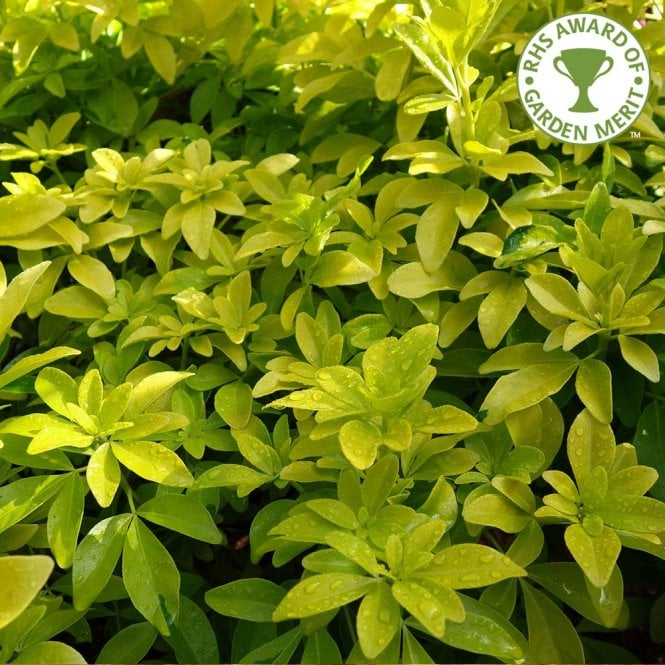 The boxwood crown is very dense due to small leaves with a glossy sheen.
The boxwood crown is very dense due to small leaves with a glossy sheen.
Boxwood is not picky about growing conditions, it can grow both in the sun and in partial shade. Under artificial conditions, in greenhouses and botanical gardens, boxwood is rarely affected by diseases and pests. It is necessary to monitor the appearance of scale insects and spider mites. But in their natural habitat, boxwood groves are subject to attacks by the boxwood moth, which destroys the trees completely.
Holly mahonia
Holly mahonia got its name from the shape of the holly-like leaves. Many people are familiar with this form of a leaf with pointed edges due to its use in New Year's compositions. Magonia leaves are dense, glossy, dark green in color. In autumn they change color to golden.
Holly mahonia grows quite slowly. Adult bushes do not exceed 100-120 cm in height. Forms a large number of root shoots. In spring, the plant is covered with panicles of lemon-yellow inflorescences.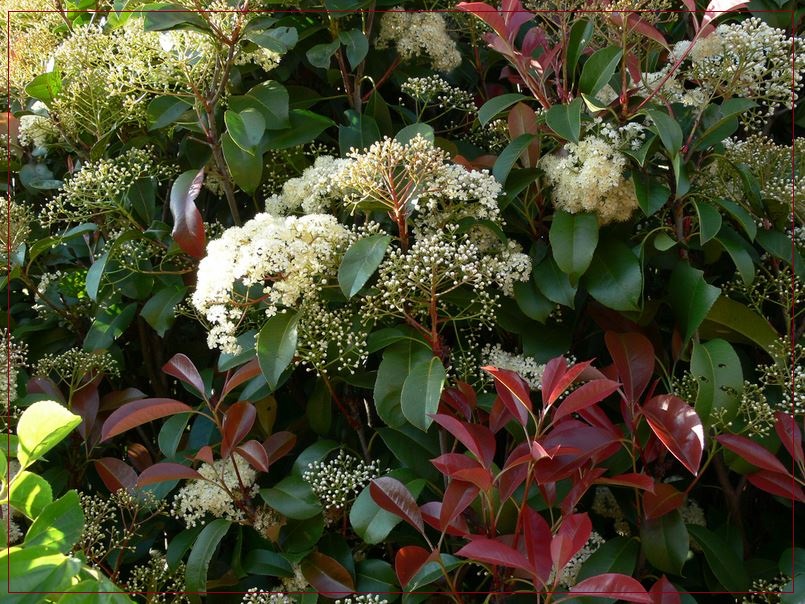 Clusters of bluish-gray berries that adorn the bush in autumn are not just decorative, but even edible.
Clusters of bluish-gray berries that adorn the bush in autumn are not just decorative, but even edible.
Mahonia is unpretentious, it can grow both in the sun and in partial shade. Prefers moist soil. In the middle lane, in the Moscow region, the holly mahonia winters in the open ground, covered with snow.
Bare branches may freeze, but the plant recovers quickly.
Barberry is a wonderful evergreen shrub that is actively used by landscape designers. Barberries are planted both in mixed plantings and for the formation of hedges. There are a lot of species of barberry, breeders annually bring out new varieties. Some of them, especially hybrids of Polish selection, have high winter hardiness and withstand frosts down to -30°C.
The most common species in landscaping is the Thunberg barberry. Unlike the common barberry, it is not so strongly affected by powdery mildew. Barberry is loved by gardeners for the great variability of leaf colors. Atropurpurea has a purple color, Aurea has a yellow color, Golden Ring has purple leaves with a golden border.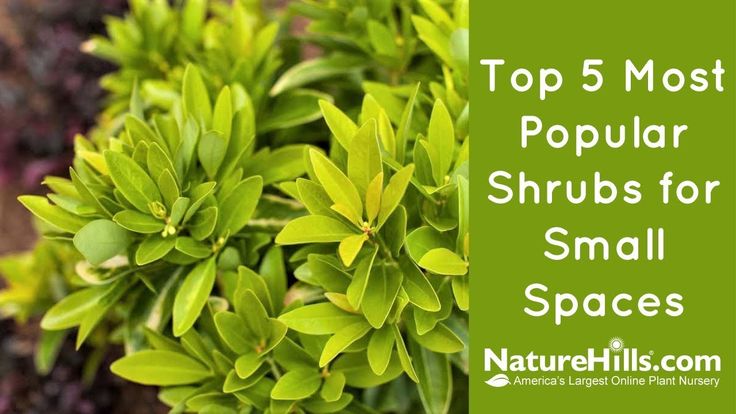 There are varieties with variegated leaves, for example, "Harlequin".
There are varieties with variegated leaves, for example, "Harlequin".
Barberries prefer to grow in open places, in the shade they lose their specific color of leaves. In the sun, barberries bloom, and in autumn they are covered with small juicy edible berries. They do not tolerate stagnant water.
Juliana barberry and warty barberry are not so well known to gardeners. These are green-leaved evergreen shrubs.
Many gardeners know cotoneaster brilliant. It is a deciduous shrub with small, dark green leaves that tolerates pruning well and is often used to form flower bed fences and hedges.
There are many types and varieties of cotoneaster. There are also evergreen species among them. For example, Dummer's cotoneaster.
This shrub can rather be called a ground cover, because its shoots spread along the ground at a height of 15-20 cm, forming a dense green carpet. One plant in a few years is able to cover several square meters. Cotoneaster Dummer is often planted on slopes, slopes. Combinations with horizontal juniper are especially interesting.
Combinations with horizontal juniper are especially interesting.
Dummer's cotoneaster is not very noticeable, it blooms with small white flowers, but in late summer the whole plant is covered with bright red berries, similar to rowan berries, which makes it look very elegant.
Pachysandra apical
Pachysandra apical forms a dense evergreen carpet. It is often used to strengthen slopes, since the plant has a developed superficial root system.
The height of pachysandra does not exceed 30 cm. The plant is covered with dense small leaves of juicy green color, some species are distinguished by a lighter color of the leaves, closer to light green.
Pakhizandra grows rather quickly, forming dense clumps. The plant prefers partial shade and moist soil. Quite frost-resistant, winters in the middle lane without shelter.
Derain has long been known to many gardeners and is loved for the unusual bright raspberry or purple color of the shrub branches, which enliven the winter monochrome landscape so much.
Most types of white turf are deciduous shrubs with high winter hardiness. Some, like the variety "Elegantissima", have bluish-green leaves, others, like "Sibirica", have a smoky-burgundy color.
But not many people know the type of Canadian turf.
This evergreen groundcover is very decorative with rich green leaves and original four-petaled white flowers. Derain Canadian frost-resistant, suitable for cultivation even in the northern regions.
Fortune's euonymus
Fortune's euonymus is an evergreen shrub remarkable for its unpretentiousness. It is characterized by high winter hardiness, easily tolerates frosts down to -35°C. Fortune's euonymus is grown as a ground cover, the height of the bush does not exceed 30 cm. But due to the structure of long, up to 3 m, stems with suckers, it can climb walls. Of course, without snow shelter, winter hardiness will be much lower.
Fortune's euonymus is prized for its ornamental foliage. There are many varieties with variegated color.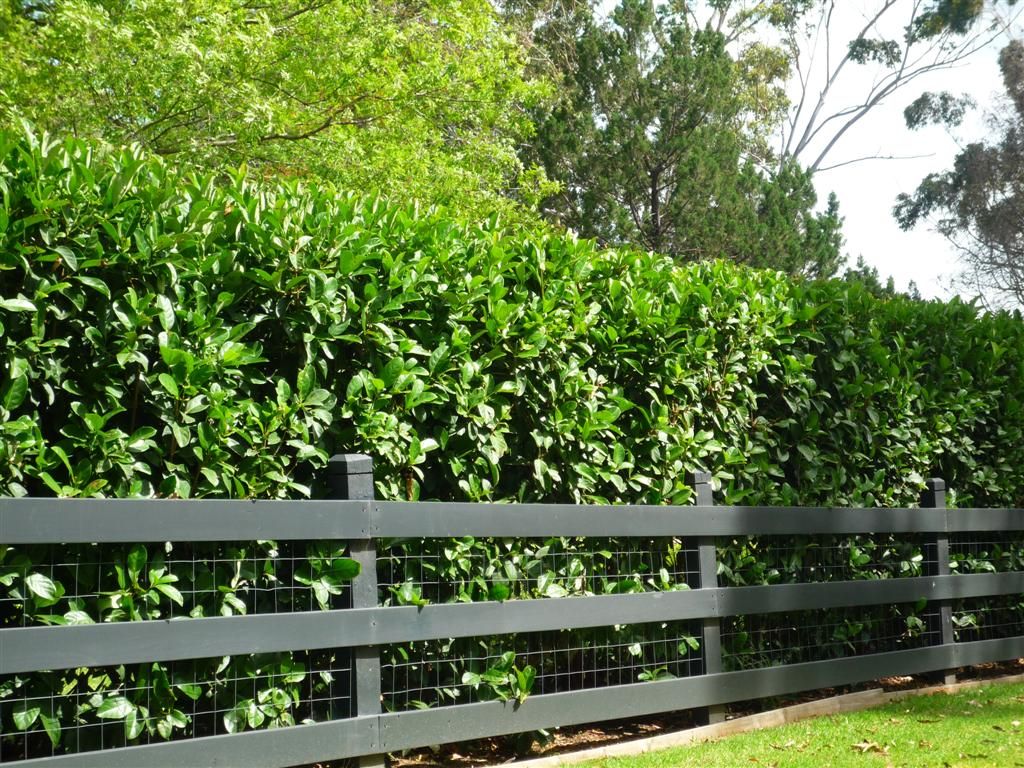 For example, "Emerald Gold" with emerald-colored leaves with a golden border or "Emerald Gaeti" with dark green leaves with a white border.
For example, "Emerald Gold" with emerald-colored leaves with a golden border or "Emerald Gaeti" with dark green leaves with a white border.
Fortune's euonymus feels great both in the sun, where it fully shows the beauty of the leaves, and in partial shade.
The use of evergreen shrubs in garden planting gives more possibilities. With their skillful combination with coniferous plants, you can create interesting compositions that will delight the eye even in the cold season.
Evergreen shrubs for the garden: description, types, planting, cultivation and care
Evergreen shrubs for the garden: description, types, planting, cultivation and care
Evergreen shrub in central Russia is no longer a rarity. You can plant coniferous or deciduous specimens. Some plants deserve special attention due to their high decorativeness.
Species, varieties and their description
- One of the most popular evergreens is holly mahonia. This is a bush up to 1.
 5 m high with leathery shiny leaves that look very impressive. In summer they are dark green, in autumn and winter they are purple or red-gold. Mahonia blooms in spring, in early May, with yellow fragrant flowers collected in large brushes. Sometimes there is a second flowering in October.
5 m high with leathery shiny leaves that look very impressive. In summer they are dark green, in autumn and winter they are purple or red-gold. Mahonia blooms in spring, in early May, with yellow fragrant flowers collected in large brushes. Sometimes there is a second flowering in October. - Evergreen boxwood is popular in ornamental horticulture, there are varieties with yellow foliage. This is an undemanding plant that tolerates summer drought and winter frosts well. Popular varieties: Elegance, Safrutikosa, Blauer Heinz.
- Holly mezerva. The branches of the shrub are strewn all winter with yellow or red fruits and green graceful leaves. Holly is credited with the power to ward off evil spirits. Popular varieties: Blue Angel, Golden Princess, Blue Maid.
- Rhododendrons look very exotic among snowdrifts of white snow. Incredibly beautiful flowering of rhododendrons, but a strong aroma can cause a headache. Many varieties that can grow in central Russia are popular.
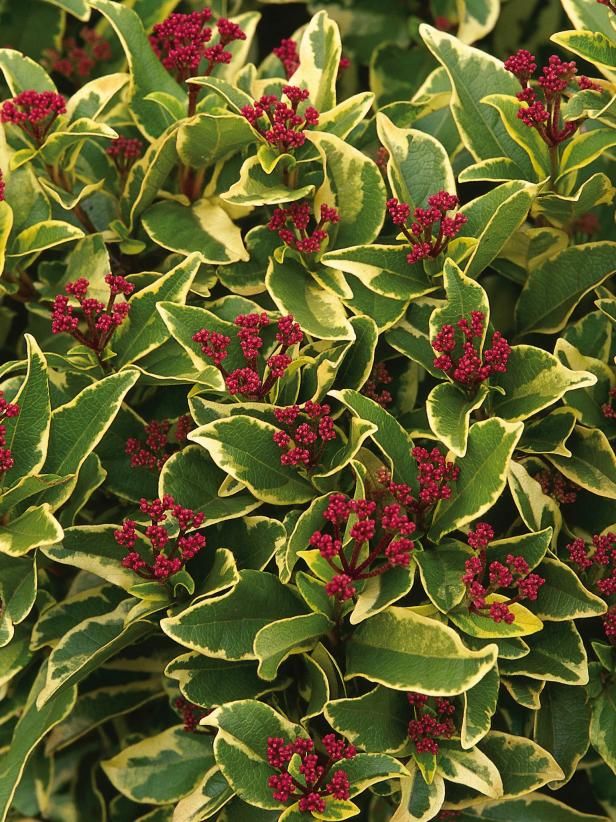 With pink flowers - Caroline, Makino, Schlippenbach, Irene. Blooming with yellow and orange flowers - "Keizuke", "Flava", "Warda". With white flowers - Metternich, Caningham White, Fortuna. Red-flowered - "Smirnova", "Karaktakus", "Alfred". Blooming purple, blue, blue flowers - Lavendula, Azurvolke, Precox.
With pink flowers - Caroline, Makino, Schlippenbach, Irene. Blooming with yellow and orange flowers - "Keizuke", "Flava", "Warda". With white flowers - Metternich, Caningham White, Fortuna. Red-flowered - "Smirnova", "Karaktakus", "Alfred". Blooming purple, blue, blue flowers - Lavendula, Azurvolke, Precox. - Thuja belongs to evergreen coniferous trees or shrubs from the genus Cypress. In the conditions of central Russia, Thuja western is often grown. Popular dwarf forms: Globoza, Globoza Nana, Europe Gold, Compacta, Little Jam, Little Champion.
- Junipers are evergreen coniferous shrubs from the Cypress family. There are large, undersized and creeping species. Green leaves are needle-shaped or scaly. In culture, the following types of juniper are most common: horizontal (or prostrate), Chinese, rocky, virgin, Cossack, ordinary, scaly.
Climbing evergreen shrubs are also grown in cultivation, which bloom very beautifully. For example, bougainvillea. But this plant does not tolerate frost, therefore it is unsuitable for planting in open ground in temperate latitudes.
Features of planting in open ground
The day before planting seedlings in containers, they are watered to make it easy to remove the earthen ball from the pot. The planting pit is made slightly larger than the volume of the container in which the plant grew. At the bottom of the pit, drainage is poured from broken bricks with sand. The distance between seedlings is from 0.5 to 2 m, depending on the type and variety of the plant, as well as the desired effect.
- Junipers are undemanding to soil fertility. A soil mixture of peat, sand and soddy soil is poured into the prepared pit.
- For boxwood, it is desirable to add perlite to the planting hole so that the earth is light, well passes water and air.
- Rhododendrons also cannot grow on heavy soil and where there is stagnant water. The soil mixture for filling the hole is prepared from peat, coniferous litter and leaf soil (2: 1: 3), adding 70 g of complete mineral fertilizer per 1 plant.
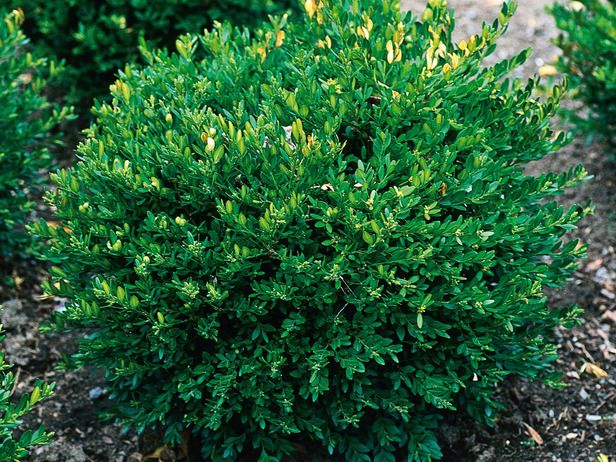
- Holly does not tolerate transplanting well. For him, choose a shady place in the garden with fertile, moist soil.
- Mahonia can be transplanted at any age, it is desirable to allocate areas open to the sun for it. In dense groups, it is placed at a distance of 1 meter, as it grows strongly. The plant does not tolerate a late autumn transplant.
- Thuja is undemanding to soil fertility and illumination. However, it does not tolerate stagnant moisture at the roots, so the earth must be well drained.
Care of evergreen shrubs in the garden
Evergreen shrubs for the garden are usually unpretentious, they require standard care - removing weeds in the trunk circle, loosening the soil, watering, fertilizing.
- Magonia is hardy, not afraid of heat and frost. Water the plant in the summer once every two weeks (10 liters of water per plant). Feed twice a season - in early spring and in May before flowering "Kemira station wagon".

- Holly shade-tolerant, loves moisture, does not tolerate drought. In spring, cover the plant from the sun to protect it from burns.
- Junipers are fertilized once a season - in spring. The plant is drought-resistant, does not need frequent watering.
- Thuja in the spring, in April, is fertilized with Nitroammofoska.
- Virginian juniper is drought-resistant, other species do not tolerate dry air. After watering, shallow loosening of the soil and mulching are carried out.
- Rhododendron is fed with potassium sulphate or superphosphate in early spring. The second time they do it after flowering. On hot days, water regularly and plentifully, 2-3 times a week, with soft water.
- Boxwood needs cutting, watering, fertilizing. The more you feed, the more often you will have to cut.
Winter Care Tips
All evergreens need shelter from the sun and cold wind in winter. The roots are protected from freezing of the ground with mulch and spruce branches, and in early November, abundant water-charging watering is carried out.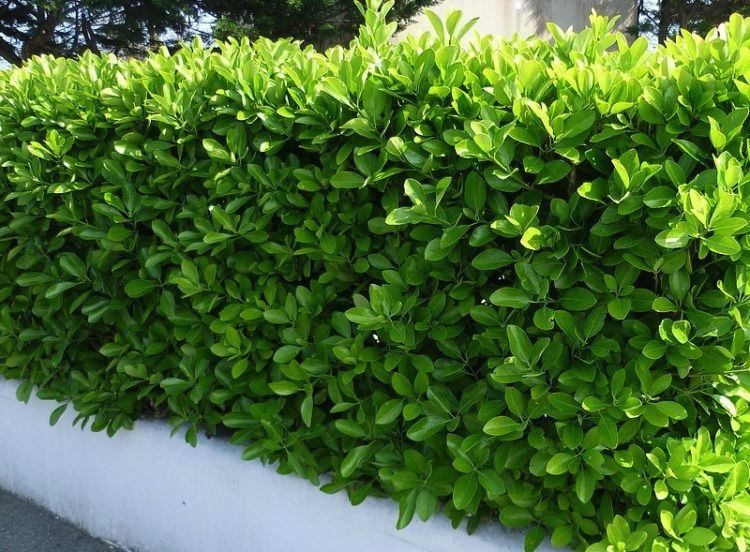 Young bushes are tightly tied with spanbond.
Young bushes are tightly tied with spanbond.
Types of evergreen shrubs, adapted to the conditions of central Russia, well withstands frosts near Moscow in the shade and with covered roots.
Mature plants that wintered without shelter are loosely covered at the end of February from the sun with spunbond or burlap.
Disease and pest control
Evergreen shrubs suffer from fungal diseases and insect pests. Fungicides are used to control various blotches and rot. Preventive treatment is carried out in early spring and autumn.
For insect control, systemic or contact insecticides are used after pests are detected on the leaves.
Hedge applications
Evergreen shrubs are well suited for hedges. They never lose their decorative effect. Each species has a special advantage.
- Boxwood is valued by gardeners for its dense crown with small shiny foliage. The bush tolerates a haircut very well, allowing you to create beautiful hedges.

- Magonia Holly is planted at a distance of 30 cm to create low hedges. It does not need frequent pruning, the bushes are sheared after flowering.
- Thuja tolerates shearing well, suitable for creating various architectural forms and garden hedges of various heights.
- Rhododendron looks good in hedges, when planting it is recommended not to mix evergreen and deciduous varieties.
But the holly is not very suitable for creating a hedge, brightly lit, open areas are contraindicated for it. It is best planted in the shade of trees. Also, only certain types of juniper are suitable for hedges.
Other ways to use plants in landscape design
Junipers blend well in the garden with heather, roses and other perennials, they are beautiful as a tapeworm in the lawn. And holly branches with graceful green leaves and red berries in many countries serve as a decoration for Christmas. Beautiful park figures are created from boxwood, singly or in groups located on lawns and along garden paths.
Holly mahonia goes well with roses. And the rhododendron looks great in group plantings near water bodies, on rocky hills, as a tapeworm on parterre lawns.
Deciding to decorate the garden with evergreen shrubs, one can hope that with minimal care and competent preparation for winter, these plants will please the owners for a year.
Top 10 Ornamental Shrubs for the Garden with Bright Leaves
Ornamental shrubs with bright foliage are found in summer cottages and also adorn urban plantings. They are used as single plantings, for decoration of hedges, as a background for other plants or as the main accent in the garden. We bring to your attention the most popular and at the same time undemanding shrubs to the soil and conditions of maintenance.
Barberry
King of colors. Such a variety of colors, perhaps, will not be found in any other plant. Green, yellow, red, purple The color of the leaves changes each other during the summer, and we are not talking about varieties in which the leaves are decorated with a rim or have a variegated color. In winter, , when the last leaves fall, scarlet berries, which ripen at the end of autumn, take over the decorative baton. Snow-white winter becomes a beautiful canvas for thin stems with numerous rows of berries.
In winter, , when the last leaves fall, scarlet berries, which ripen at the end of autumn, take over the decorative baton. Snow-white winter becomes a beautiful canvas for thin stems with numerous rows of berries.
Evergreen flowering shrubs
In the article we will tell you about the most popular and common types of shrubs among summer residents with photos and names.
ARBUTUS
Russian name for strawberry tree, strawberry. A slow-growing shrub that has hanging flowers and strawberry-like fruits on the plant at the end of autumn - these fruits are tasteless. The popular large-fruited strawberry reaches a height of 2 m. Its flowers are white. Flowering time: October - December
Evergreen shrub-Trachycarpus
Blooms in June, loves full sun. The plant is hardy, able to endure winter frosts in many regions, but requires protection from gusts of icy winds.
Huge inflorescences are formed at the beginning of summer, individual specimens grow up to three meters in height, leaf width up to one meter.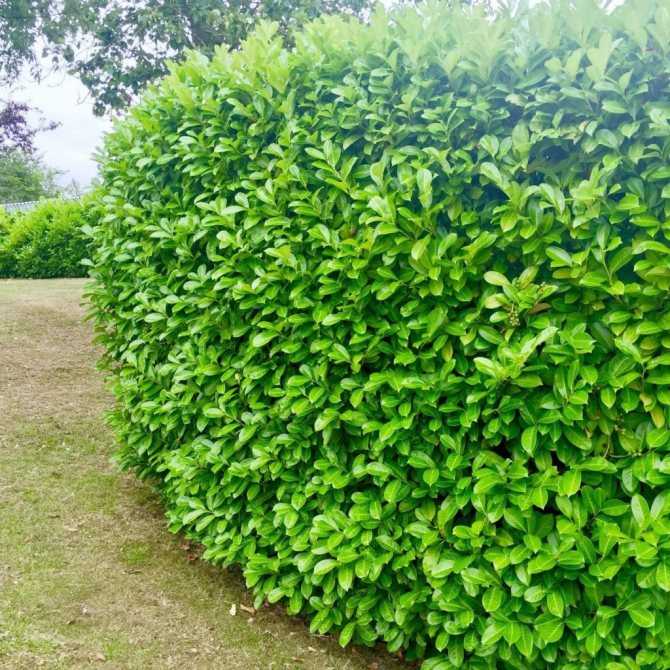
Holly mahonia
Holly mahonia is an ornamental evergreen shrub up to 4 m high. This plant grows best in shade or partial shade. Young mahonia leaves are orange-green in color, which becomes dark copper in winter.
Tolerates cold well, propagated by seeds.
This shrub blooms very beautifully with small yellow flowers collected in hats. Many sources attribute this species to the genus Barberry under the name Berberis aquifolium
Holly - an evergreen shrub
Symbol of Christmas, it is traditionally decorated with houses during the winter holidays. Holly is an evergreen shrub that blooms from October to December, easily tolerates shading, but it is not a shade-loving plant. The greatest contrast of colors in this plant appears precisely in the sun.
Holly is especially beautiful in winter, when bushes with bright green leaves and beads of red, white, yellow, black and orange berries stand out clearly on the snow, which remain on the bushes all winter.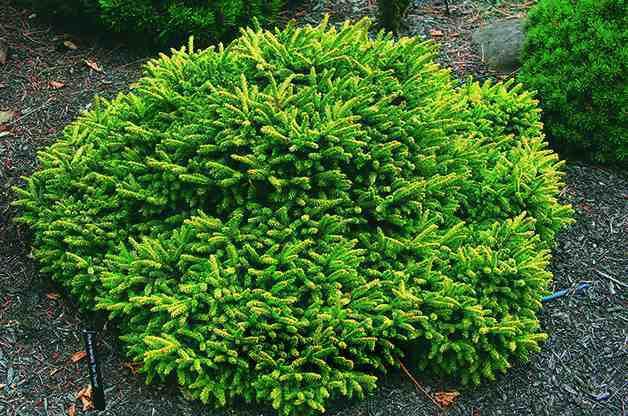
Evergreen Iberis
This is a branched, low evergreen shrub with small, dense and narrow green leaves. The plant is very fond of light and blooms with white flowers in the month of May.
Photos of Iberis
Camellia
It is an evergreen shrub with dense glossy dark green foliage. It blooms unusually beautifully, forming inflorescences similar to roses.
Photo of Camellia
But the value of this evergreen shrub is that its flowering begins ... in autumn and lasts up to three months.
Boxwood - BUXUS
Boxwood can withstand wind, alkaline soils and some shade. The stems can be cut regularly. The boxwood evergreen shrub will grow up to 3m if left unpruned.
Boxwood variety 'Aureovariegata' has yellow spotted leaves; "Suffruticosa" - dwarf. Propagated by cuttings under glass in summer. Russian names for boxwood are boxwood, green tree, gevan, bukshpan, shamshit
Choizia
Choisia is a rounded evergreen shrub with densely leafy crown all year round.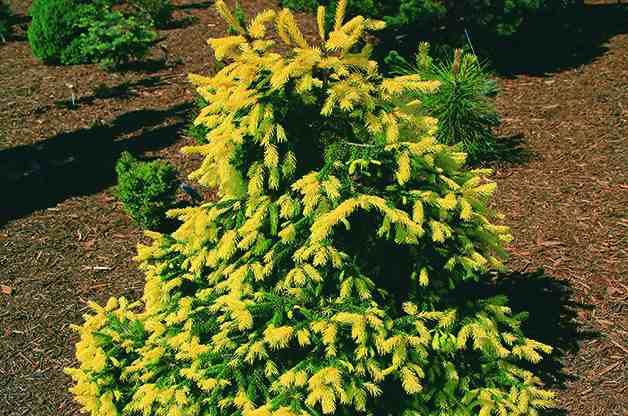 Flat inflorescences of wax flowers appear in spring - both leaves and flowers are fragrant.
Flat inflorescences of wax flowers appear in spring - both leaves and flowers are fragrant.
Photos of Choisia
Choisia trifoliate - 2 m high. Flowering time: April - May. Location: sunny or slightly shady. Reproduction: cuttings under glass in summer.
Callistemon
Callistemon blooms in the first two summer months. It is recommended to plant in places well lit by the sun. Propagated by cuttings planted in the summer under a glass canopy.
Flowering is small, stamens are produced in tightly collected cylindrical inflorescences. Usually planted on the sun-facing side of the site. Flowering is dark pink, the foliage is long. The height of the lemon-yellow callistemon can reach two meters, and the hard callistemon is only one and a half meters, but it is famous for its endurance.
Video - Evergreens in the garden
Winter garden with evergreens
In winter, the garden can be green and beautiful with evergreen shrubs and trees that retain their foliage and color on cold days.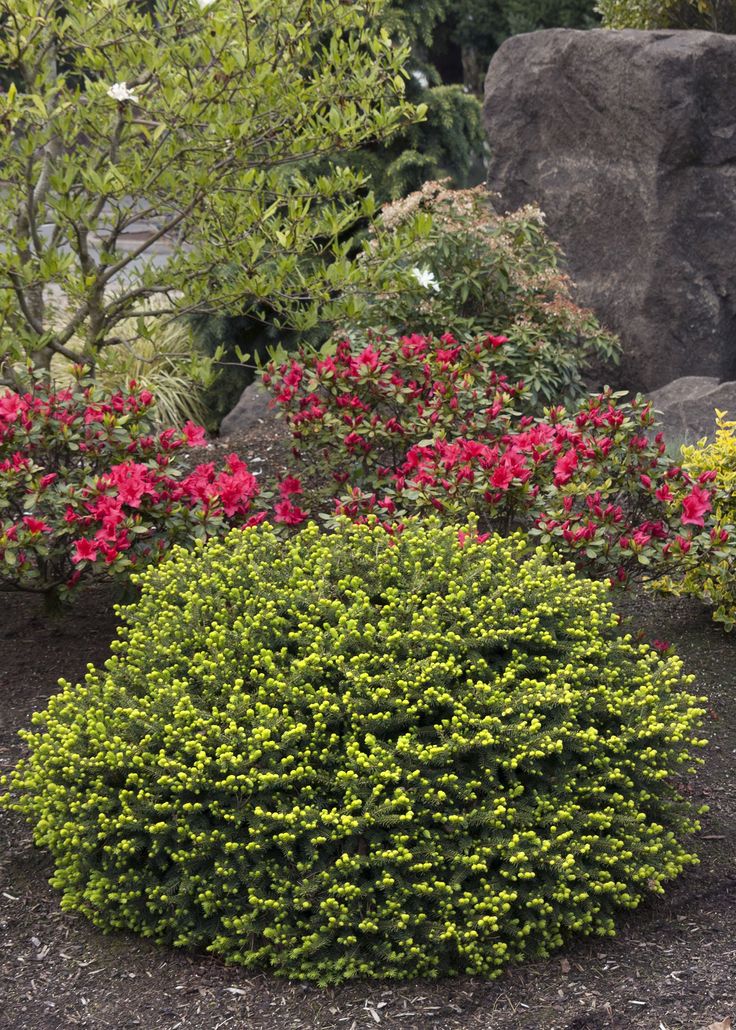 Some retain fruit.
Some retain fruit.
Euonymus
Belongs to a separate genus of the Euonymus family, with about 200 varieties. In our country, about 20 species of this plant are used as cultivated plants. The leaves of Fortune euonymus are bright green or variegated, interspersed with white. Winged euonymus is completely different - pink, carmine-red, maroon bushes are visible from afar. Euonymous trees are planted as spectacular tapeworms, and they are also indispensable for creating hedges.
Pea cypress
Variety: “Filifera Aurea Nana”
Another miniature shrub. But this time - evergreen. The cypress plant attracts gardeners and landscape designers, first of all, with its filamentous shoots, and secondly, with its compactness. The maximum height of a cypress is a meter. The maximum diameter of the bush is one and a half meters. But for this representative of the evergreen flora to reach such dimensions, many years must pass.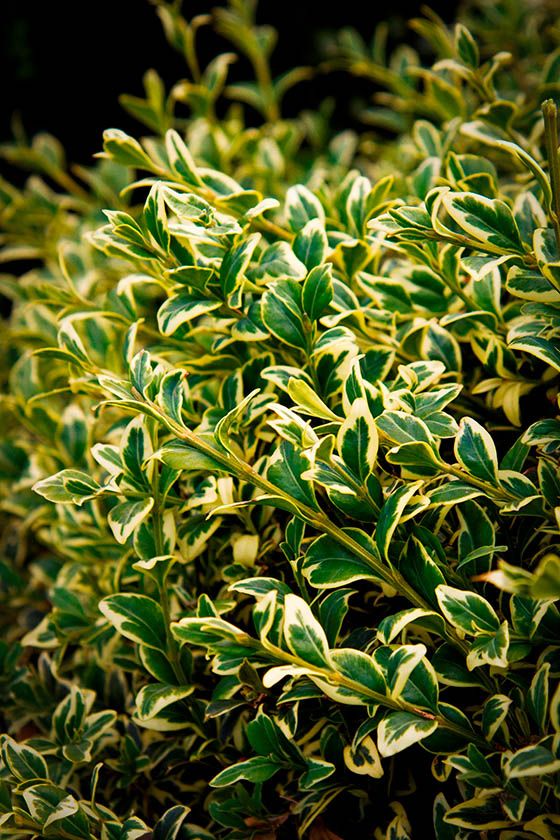 Within 12 months, the pea-bearing cypress grows a maximum of four centimeters. Requires very little space. Ideal for rock gardens and rockeries.
Within 12 months, the pea-bearing cypress grows a maximum of four centimeters. Requires very little space. Ideal for rock gardens and rockeries.
Cypress is best planted in acidic soil. In this case, the location should not be shady, since the lack of sunlight negatively affects the color of the shoots. The golden hue of the green mass of this shrub becomes more saturated over time, making it easy to understand where the cypress has old shoots and where the young ones. But this does not spoil the look of the plant. From a distance, this mix looks like a balayazh technique on long female hair.
Derain
Already in spring, the color of the bark on the shoots attracts attention. They are bright red. Large green, yellow with a white border and splashes, leaves in the autumn of different varieties of derain are painted in burgundy, yellow and red shades.
Types and varieties of holly with photo
Holly or European holly (Ilex aquifolium) from central Europe is the most popular species in horticultural culture. It is an evergreen shrub or small tree with a conical crown. The annual growth is about 20 cm in height.
It is an evergreen shrub or small tree with a conical crown. The annual growth is about 20 cm in height.
Leaves are dark green, shiny with characteristic spiny teeth. Coral-red fruits ripen in autumn. In Europe, holly twigs are used to make wreaths and other Christmas decorations.
The most beautiful varieties of this species are:
- variegated variety "Silver Queen" - in the spring on young, purple shoots bloom pinkish leaves, which by the summer become dark green with a wide cream border;
- 'Madame Briot' is a very ornamental cultivar with bright yellow margins and spots on dark green foliage, orange-red berries;
'Madame Briot'
- 'Argenteomarginata' is the pride of this variety, not only for its dark red fruits, but also for its dark green leaves with white or silver edges.
- 'Aureomarginata' - very sharply toothed foliage, green with golden yellow margins;
'Aureomarginata' in garden design
- 'Amber' is distinguished by the apricot color of numerous fruits;
- 'Golden Van Tol' and 'Silver Van Tol' are small, spreading shrubs with dark green leaves edged with yellow and silver.
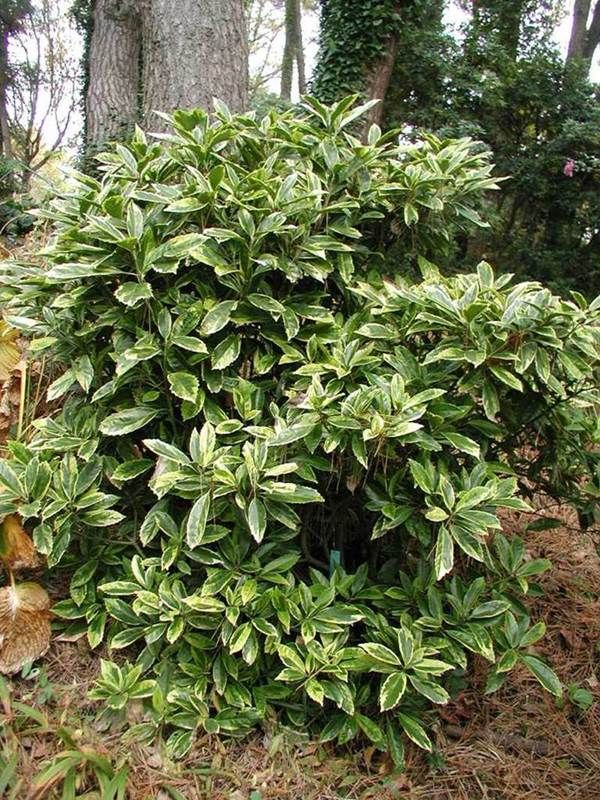
"Golden Van Tol"
These cultivars do not require male specimens for fruit set.
Altaclerensis Holly (Ilex × altaclerensis) is a hybrid that was bred in England at Highclere Castle (Hampshire) in 1835 by crossing I. aquifolium and the heat-loving species I. perado.
The following varieties have received RHS (Royal Horticultural Society) certification from the Royal Horticultural Society, one of the leading horticultural organizations in the world:
'Golden King' - purple stems with leaves edged with broad yellow edging, some leaves entirely lemon yellow, deep red berries;
'Golden King'
'Lawsoniana' - almost spineless foliage with bright yellow and pale green spots, dark red berries;
Cultivars also look impressive: "Belgica Aurea", "Golden King", "Camelliifolia".
Meserva's Holly (Ilex x meservae) Another highly ornamental hybrid created by housewife Kathleen K. Meserve of St. James by crossing Holly and Japanese species.
Meserve of St. James by crossing Holly and Japanese species.
The result was a series of cultivars, most of which are known under the name "Blue Hollies" (Blue Hollies), for example: "Blue Girl", "Blue Boy", "Blue Princess".
Blue Boy Holly
Interesting cultivars have also been created such as 'Castle Gold' with golden green foliage or 'Little Rascal', a compact and slow growing cultivar with shiny, serrate-edged leaves that turn dark green in cold weather. partially painted in copper-red shades.
Common holly (Ilex crenata) also known as small-leaved holly. It is an evergreen shrub that can freeze in winter, so it should be protected from frost and strong winter winds.
How to grow moss in the garden
A characteristic feature of the species are small leaves, somewhat reminiscent of boxwood. This plant prefers fertile, acidic soils and does not tolerate wetlands.
Varieties of this species
Golden Gem Holly is a small and compact evergreen plant with bright golden yellow foliage.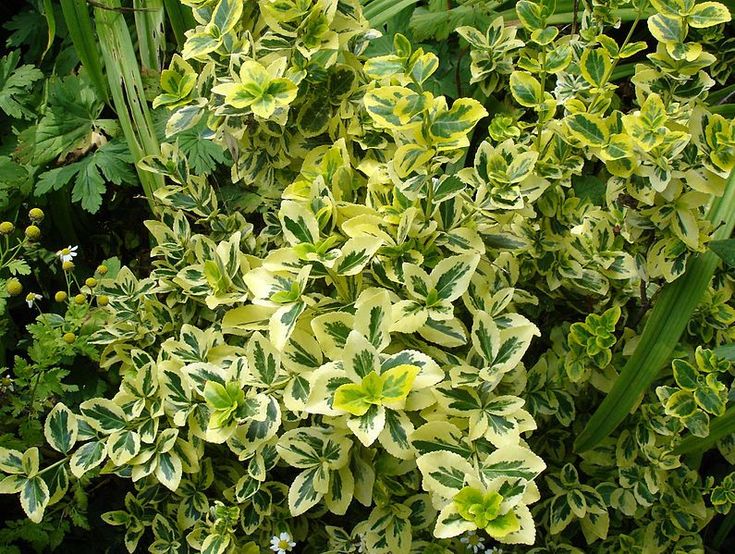 It is best grown in full sun, in moist but well-drained soil. Withstands frosts down to -15 °C.
It is best grown in full sun, in moist but well-drained soil. Withstands frosts down to -15 °C.
Variety "Golden Jam"
Holly crenate "Glory Gem" (Glory Gem) is a compact, frost-resistant semi-circular shrub, reaching 80-150 cm in height. Both varieties are ideal for forming low hedges and topiary.
Whorled holly (Ilex verticillata). Dense, deciduous shrub, 2 m high, with bright green oval or spear-shaped leaves and serrated but not prickly margins.
Ilex verticillata
Inconspicuous greenish-white flowers that bloom in spring on female plants give way to clusters of bright red berries in September.
Japanese holly (Ilex pedunculosa) is a small, compact, pyramidal tree growing to about 2 m in height. Differs in very high frost resistance.
Ilex pedunculosa
Interesting! One of the most astounding collections of holly varieties in the world is found in France. Pierre Paris, the owner of the land in Maine-sur-Loire, has turned his plot into a national garden, where only this plant is grown.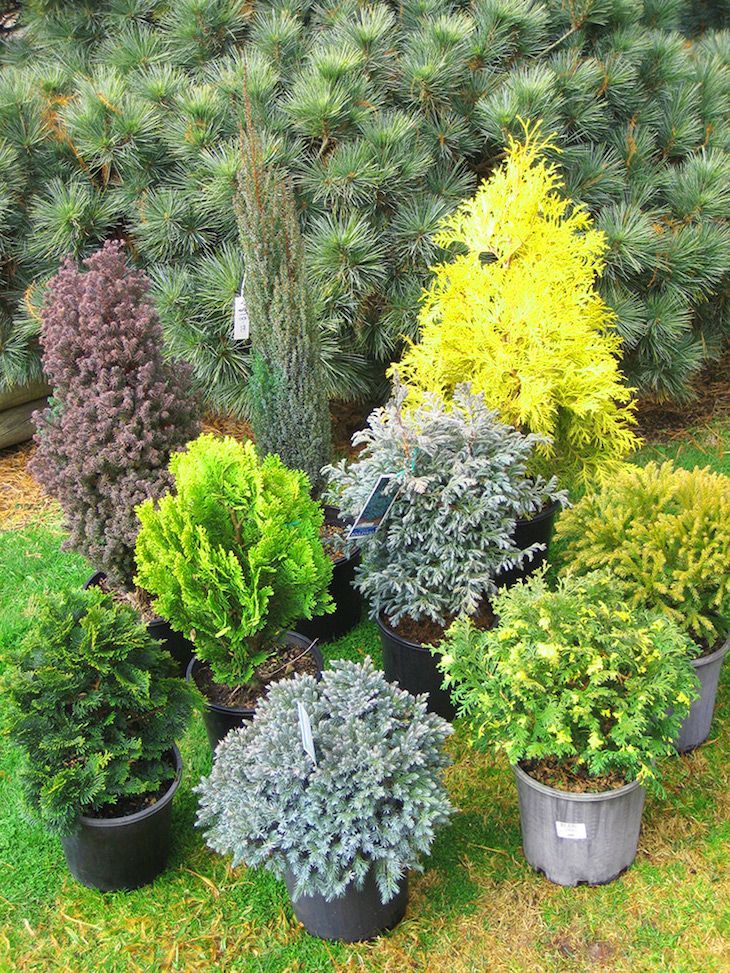 The Pierre Paris collection includes more than 400 different varietal forms.
The Pierre Paris collection includes more than 400 different varietal forms.
Viburnum common
Viburnum is beautiful throughout the year. In the spring of white flower caps attract attention. In autumn leaves turn burgundy, red berries ripen. Clusters of viburnum turn red in the garden throughout the winter. Shrubs practically do not need to be looked after. Kalina does not require watering and top dressing.
Red Elder
Variety: Sutherland Gold
If you need to get results as soon as possible by planting some ornamental shrub for accent or in mono-planting, bet on one of the red elderberry varieties. "Sutherland Gold" is distinguished by its rapid and very intensive development. Within one season, this representative of the flora is able to grow up to three meters in height, so the shrub will need to be trimmed regularly. At the beginning of spring, when some representatives of the flora have not even had time to release their leaves, the red elderberry is already covered with miniature lush flowers.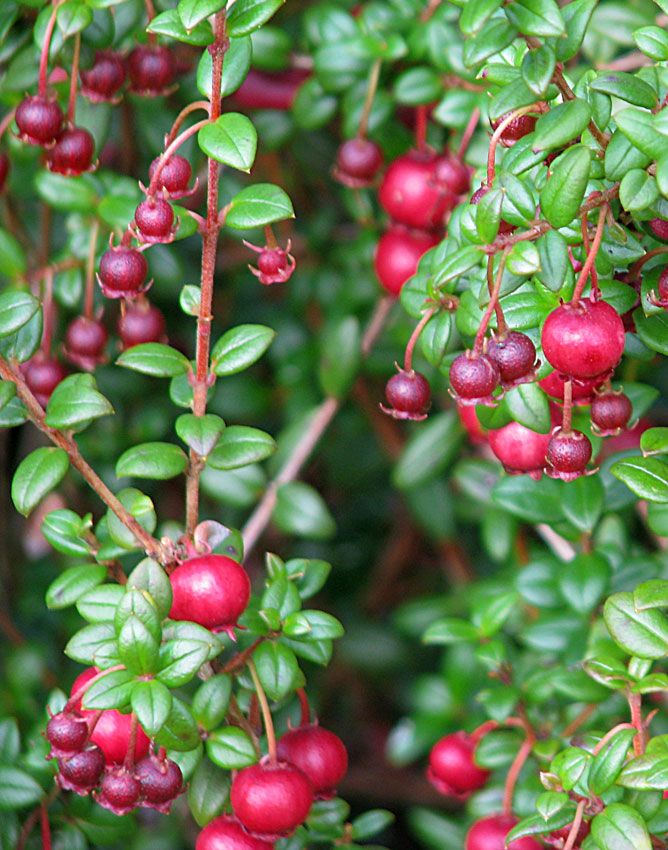 And closer to the beginning of the second third of summer, beautiful red berries ripen on the bushes. You should not eat them, but admire them easily.
And closer to the beginning of the second third of summer, beautiful red berries ripen on the bushes. You should not eat them, but admire them easily.
Sutherland Gold, like the red elderberry in general, is ready to grow in almost any soil. But it is better to land it either in the sun or in openwork penumbra. Due to the lack of sunlight, the processes occurring in the roots and stems of this plant slow down, and it begins to grow less intensively than in a sunny location.
Red elderberry flowers have a very weak fragrance. Simply put, they practically do not smell. But despite this, this bush remains one of those plants that attract beneficial insects to the site.
Cotoneaster brilliant
Serves as an excellent decoration of our gardens and is actively used in landscape design for decoration of hedges. Foliage gives decorativeness to the cotoneaster. In the summer of , small, dense, shiny leaves are painted in rich green tones on top, and their lower part is distinguished by a yellow palette. From this they create a rich color scheme. In winter cotoneaster adorns many red berries.
From this they create a rich color scheme. In winter cotoneaster adorns many red berries.
Silver sucker
Incredibly beautiful shrub has a pleasant honey aroma during flowering. Silvery Leaves plants look beautiful against tall dark green conifers or in combination with maroon barberry bushes. You can plant a shrub as a hedge or a small grove if the size of the site allows.
Mahonia, an evergreen beauty
Mahonia aquifolia
Mahonia is an evergreen plant native to western North America. The shrub grows up to one and a half meters and has leathery large leaves. The leaves are pinnate and consist of several spiny-toothed leaflets. In the process of blooming, they have a reddish tint, dark green in summer, and golden-bronze in autumn, especially if the plant grows in sunny areas. Magonia flowers are yellow and grow collected in inflorescences, which are located at the ends of the shoots. Magonia blooms in early May and continues to bloom throughout the month. Sometimes re-blooms in October. The plant bears fruits of an oblong-elliptical shape with berries that have a dark blue bloom. The berries are edible and have a pleasant sweet and sour taste. The berries ripen in early August and give the plant a very unusual look. Magonia holly is a cross-pollinated plant. A single bush does not have fruits, so mahonia is usually planted at least in pairs. The yield of the plant depends on successful pollination. If all conditions have been created for pollination, then mahonia will delight you with its fruits. But the main purpose of mahonia is its decorative effect.
Magonia blooms in early May and continues to bloom throughout the month. Sometimes re-blooms in October. The plant bears fruits of an oblong-elliptical shape with berries that have a dark blue bloom. The berries are edible and have a pleasant sweet and sour taste. The berries ripen in early August and give the plant a very unusual look. Magonia holly is a cross-pollinated plant. A single bush does not have fruits, so mahonia is usually planted at least in pairs. The yield of the plant depends on successful pollination. If all conditions have been created for pollination, then mahonia will delight you with its fruits. But the main purpose of mahonia is its decorative effect.
Mahonia bushes produce abundant root offspring, with the help of which beautiful thickets are formed near the bush. The plant tolerates shade well, and in sunny areas forms beautiful and dense bushes. Grows well in soil rich in humus, tolerates urban conditions and pruning.
Winter care
In central Russia, there is conflicting information about the winter hardiness of magonia. And not by accident. Magonia's natural habitat is North America, and the plants grow in an area stretching from north to south. Those species that grow along the southern mountain ranges of the mainland in Russia do not withstand the winter cold and most often freeze slightly. And plants that grow in the northern part have satisfactory winter-hardy characteristics. These facts were confirmed by specialists from the main botanical garden. However, in plants growing in the north and in the south, there are practically no external differences. To this must be added the fact that the resistance of a plant depends on its age. Young magonia bushes freeze much more often than bushes that are three or more years old. Therefore, when planting low-hardy forms, they must be covered for the first two winters. For winter shelter, spruce branches or fallen leaves are used, preferably oak. A film or non-woven material must be laid on top of the shelter.
And not by accident. Magonia's natural habitat is North America, and the plants grow in an area stretching from north to south. Those species that grow along the southern mountain ranges of the mainland in Russia do not withstand the winter cold and most often freeze slightly. And plants that grow in the northern part have satisfactory winter-hardy characteristics. These facts were confirmed by specialists from the main botanical garden. However, in plants growing in the north and in the south, there are practically no external differences. To this must be added the fact that the resistance of a plant depends on its age. Young magonia bushes freeze much more often than bushes that are three or more years old. Therefore, when planting low-hardy forms, they must be covered for the first two winters. For winter shelter, spruce branches or fallen leaves are used, preferably oak. A film or non-woven material must be laid on top of the shelter.
Decorative
Magonia has a decorative appearance throughout the year, but it is especially beautiful in spring, when most plants have not yet had leaves, and in Magonia, against the background of last year's leaves, young shiny leaves with a reddish tinge are already beginning to peep out. Yellow plentiful inflorescences during the flowering period look very beautiful along with shiny leaves. And with abundant fruiting, the mahonia bush looks very impressive. Magonia bushes look equally good in both single and group plantings. Usually gardeners plant it in the foreground or next to rocky hills. Magonia can also be planted in borders or low hedges. The plant has been used as an ornamental since 19century.
Yellow plentiful inflorescences during the flowering period look very beautiful along with shiny leaves. And with abundant fruiting, the mahonia bush looks very impressive. Magonia bushes look equally good in both single and group plantings. Usually gardeners plant it in the foreground or next to rocky hills. Magonia can also be planted in borders or low hedges. The plant has been used as an ornamental since 19century.
Vesicle
A hit for leafy hedges. Grows fast and easily tolerates shearing. Beautiful both during flowering and in autumn. There are several types of vesicle, for example, Diablo with purple leaves, Andre with wine-red, Aurea with gold.
Bubbleweed
Variety: “Darts Gold”
Bubbleweed is a chameleon plant. It is a rather miniature and compact bush, the young foliage of which has a golden hue. Over time and closer to the middle of summer, the color of the leaves of the vesicle changes, a pronounced lemon tint appears on the foliage.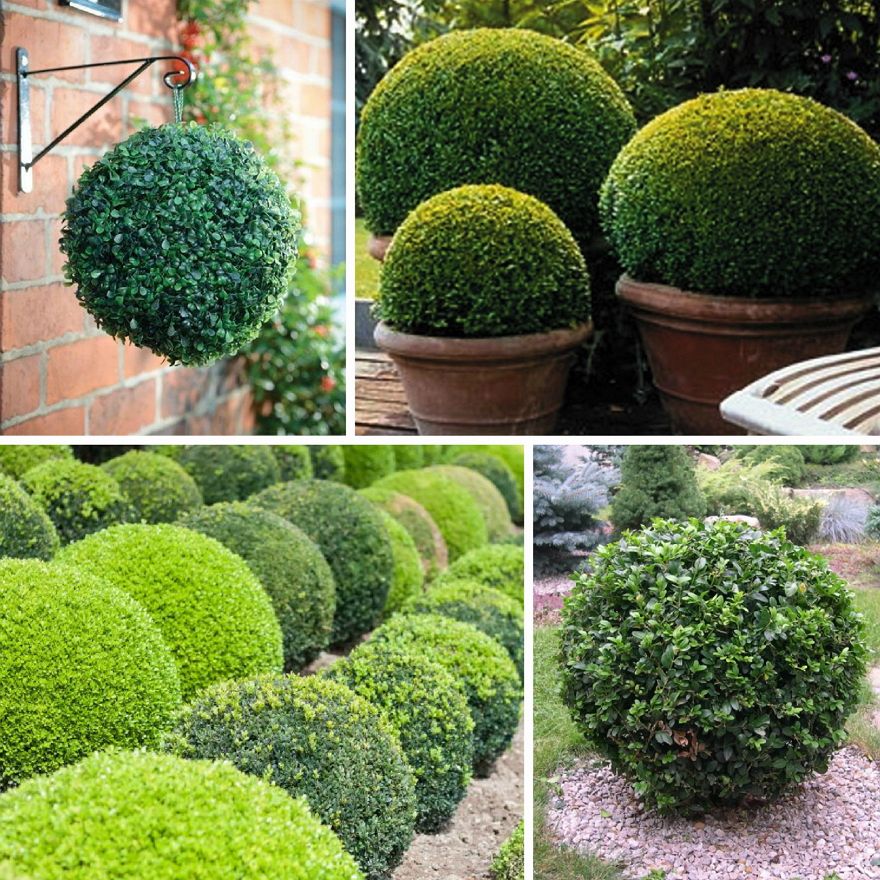 But with the advent of the autumn season, when many trees turn purple, this bush becomes orange-copper-gold - very beautiful and bright. In other words, at any time of the year (with the exception of, of course, winter), the foliage of the Darts Gold vesicle looks very decorative.
But with the advent of the autumn season, when many trees turn purple, this bush becomes orange-copper-gold - very beautiful and bright. In other words, at any time of the year (with the exception of, of course, winter), the foliage of the Darts Gold vesicle looks very decorative.
The vesicle blooms quite interestingly. Its small cream flowers are collected in lush corymbs. After flowering is completed, small scarlet berries appear in place of the flowers, which make the bush even more aesthetic and attractive than before.
Mackerel
Mackerel bushes look unusually decorative throughout the year. Compact bush up to 1.5 high. In summer and spring, is covered with ornamental foliage in shades of green, yellow, purplish red and plum. Starting in June, inflorescences of openwork pink flowers appear. The inflorescences are covered with elongated reddish hairs, creating the effect of a weightless haze around the shrub.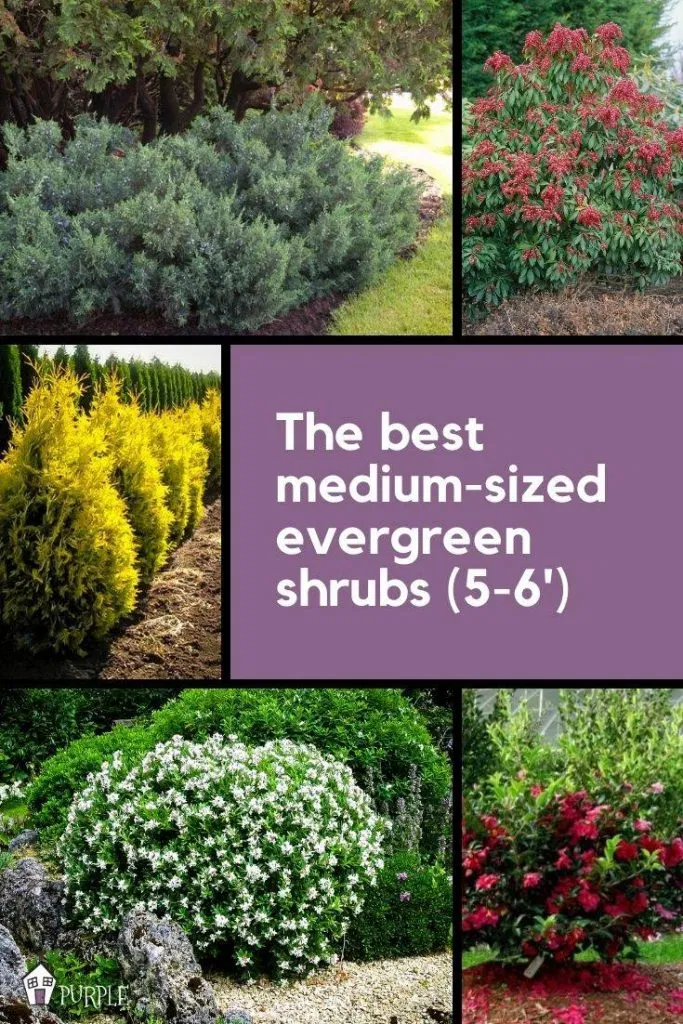
Japanese Spiraea
A plant that will perfectly complement any composition, making it truly unique. The main feature of culture is unusual leaves. In spring, they can have a variety of warm colors: red, orange, pinkish. With the onset of summer, become familiar green, and in autumn they return to spring shades again.
Wormwood
Grade: “Hang Castle”
Unusual to see such a tall and spreading sagebrush, isn't it? The height of this plant sometimes reaches one and a half meters. Therefore, the tree-like wormwood of this variety received the second - the popular name. Between themselves, gardeners call this representative of the flora "God's tree". Perhaps also because the "Povis Castle" protects the surrounding plants from pests: the stems of wormwood contain essential oils that give the shrub a special aroma and repel harmful insects.
If you decide to plant sagebrush tree in your garden, filling it with silver and fragrance, choose a sunny location for the plant.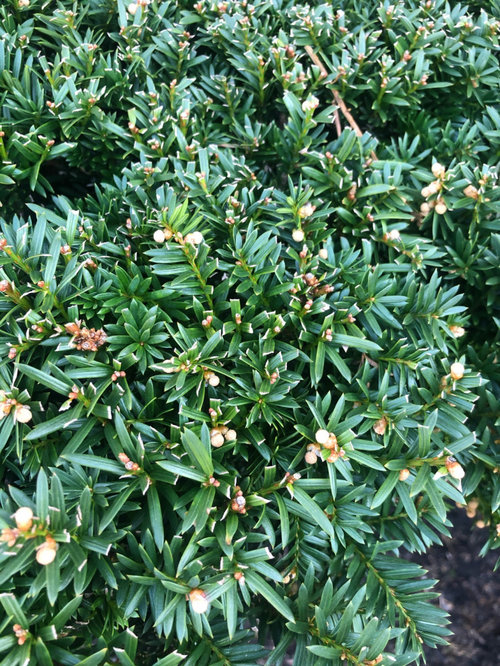 It is important that the soil is well drained. In this case, the wormwood will grow intensively and quickly. True, upon reaching certain dimensions of a tree-like wormwood, support will be needed. It can fit perfectly into an alpine hill or a composition with cereal crops, in which wormwood looks especially beneficial and bright.
It is important that the soil is well drained. In this case, the wormwood will grow intensively and quickly. True, upon reaching certain dimensions of a tree-like wormwood, support will be needed. It can fit perfectly into an alpine hill or a composition with cereal crops, in which wormwood looks especially beneficial and bright.
Join our Facebook group
Forsythia
Forsythia illuminates the garden with the sun not only in early spring, when numerous yellow flowers bloom on its branches, but also in autumn. At this time, the leaves of the shrub become golden. And sometimes - and purple-violet.
Looks good planted alone, next to coniferous plants, deciduous shrubs, hedge looks bright - freely growing and trimmed.
Buckthorn buckthorn
Sea buckthorn culture is absolutely not afraid of drought, heat or severe frost. This undersized tree with silvery foliage calmly reacts to too wet soil, is not afraid of water, and generally has established itself as a skilled opportunist that easily adapts to any life realities. Sea buckthorn is practically the sister of the previous participant in our rating - the silver sucker. In its natural habitat, this tree settles in river valleys, but in principle, sea buckthorn will grow with great pleasure in your garden.
Sea buckthorn is practically the sister of the previous participant in our rating - the silver sucker. In its natural habitat, this tree settles in river valleys, but in principle, sea buckthorn will grow with great pleasure in your garden.
The blooming of buckthorn buckthorn is nothing particularly attractive. The inflorescences of the tree are very inconspicuous and inconspicuous. But closer to autumn, in the place where the flowers used to be, bright orange fruits appear - small berries.
Sea buckthorn should only be fed with potash fertilizers. She does not need nitrogen compounds, since special bacteria live in the soil of the root system of this tree, which, in the course of their life, simultaneously supply sea buckthorn with nitrogen.
Planting and caring for ornamental shrubs
Ornamental shrub seedlings are well suited for summer cottages and ornamental gardens due to their ease of care.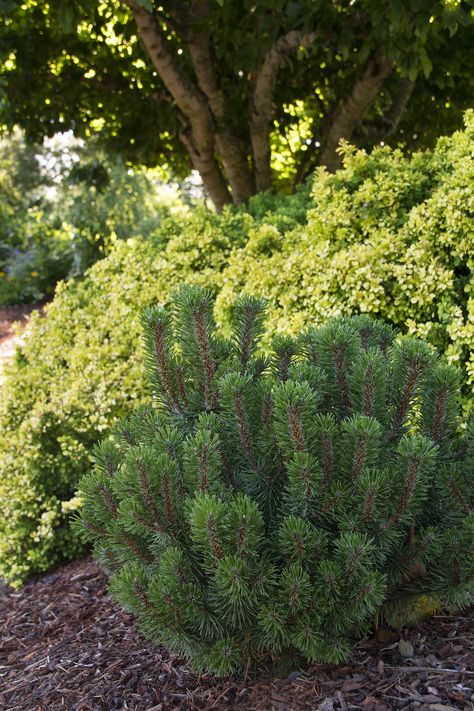
They are planted at the same level at which they grew before, without deepening the root collar. They compact the soil around, water it abundantly and mulch the soil in the near-trunk circle. In order for the plants to take root well, at first it is necessary to monitor the constant soil moisture.
Most shrubs require little maintenance . They winter well and are resistant to diseases and pests. In the spring, it is only necessary to make sanitary pruning, removing broken, dry branches. Water the plants during the summer. Shape as needed. It will take quite a bit of time. This will make the garden look amazing.
Unpretentious, winter-hardy, low-maintenance plants - the dream of any gardener. We also offer you to replenish your collection of plants with beautiful ornamental shrubs.
You can get acquainted with the assortment and prices here.
Planting Holly
These shrubs do well in both shade and full sun, but the variegated varieties show their bright colors best in full sun.




